Let’s Do Some Math: AMD Radeon R9 295X2 2x4GB Review

Today we’re talking about AMD’s new graphics card with two Hawaii XT GPUs and a liquid cooling system.
Oddly enough, AMD’s new dual-processor Radeon R9 295X2 graphics card owes its rapid release to Nvidia. It was in March that Nvidia’s head Jen-Hsun Huang showcased the GeForce GTX Titan Z with two top-end GK110 “Kepler” GPUs but it took about two months for that product to actually reach the market – and at a fantastically high price of $2999.
AMD reacted quickly. Just a week after the GeForce GTX Titan Z announcement the company released its Radeon R9 295X2 card with two Hawaii XT GPUs and actually began to sell it at only half the Titan Z’s price.
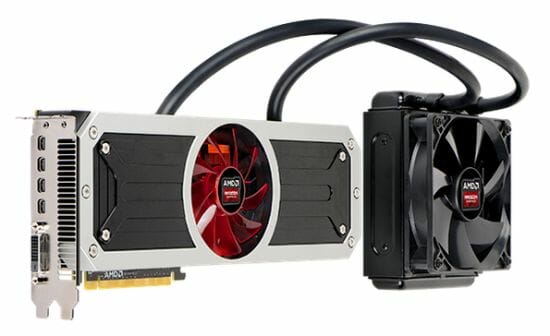
Considering that the single-processor GeForce GTX Titan is faster than the Radeon R9 290X and that Nvidia’s SLI is comparable to AMD’s CrossFireX technology in efficiency, we have no doubts about the GeForce GTX Titan Z beating the Radeon R9 295X2. However, these two cards are going to differ twofold in price. And the latter is already here and ready to be tested by us while the GeForce GTX Titan Z will arrive later.
Specifications and Recommended Price
The specs and price of the AMD Radeon R9 295X2 are listed below in comparison with those of the single-processor AMD Radeon R9 290X and the dual-processor AMD Radeon HD 7990 and Nvidia GeForce GTX 690.
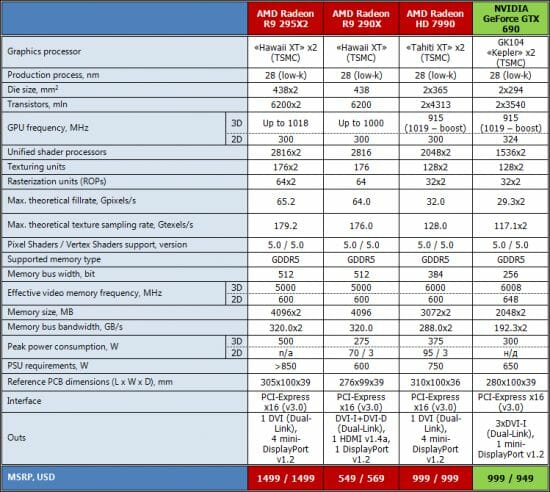
The new card came to us in OEM packaging, so let’s move on right to its PCB design.
PCB Design and Features
The AMD Radeon R9 295X2 uses liquid cooling, which makes it quite unusual in appearance. There are two pipes sticking out of the otherwise normal-looking dual-processor card. A radiator with fan is fastened to the ends of those pipes.
You may identify the cooler as one of the numerous Asetek clones. We’ll discuss its design later on. Right now, let’s have a closer look at the graphics card proper.
The dual-processor AMD Radeon R9 295X2 measures 305x100x39 millimeters, being larger than the regular Radeon R9 290X/290 but somewhat smaller than its dual-processor predecessor Radeon HD 7990. The face side of the card is covered by the cooler casing with a bright red fan in the center.
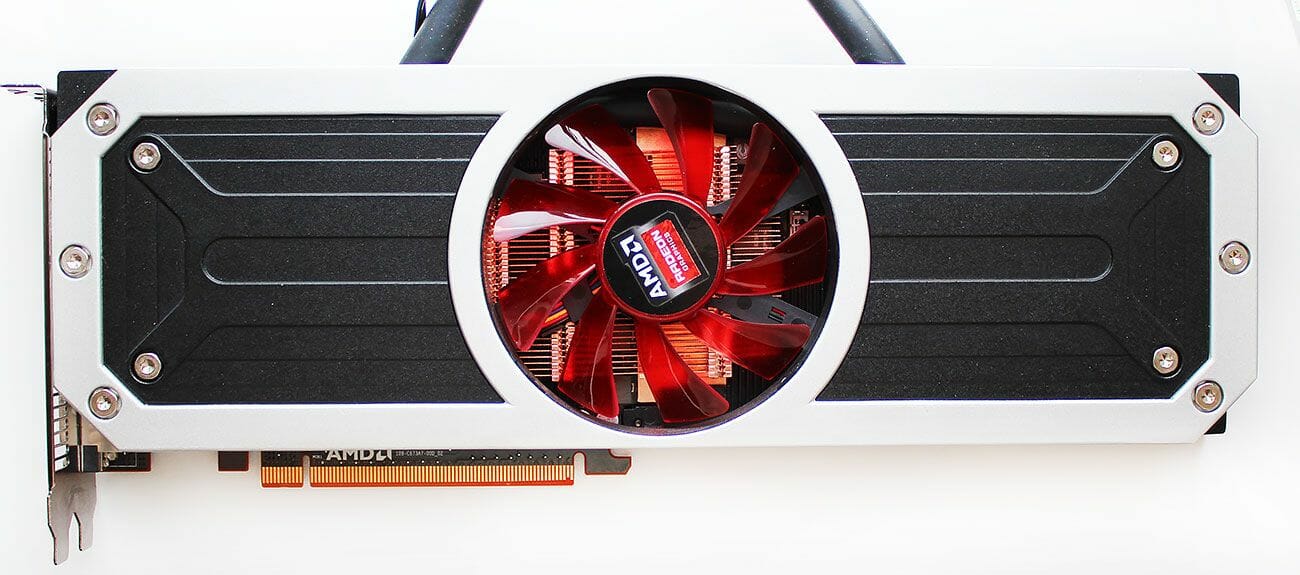
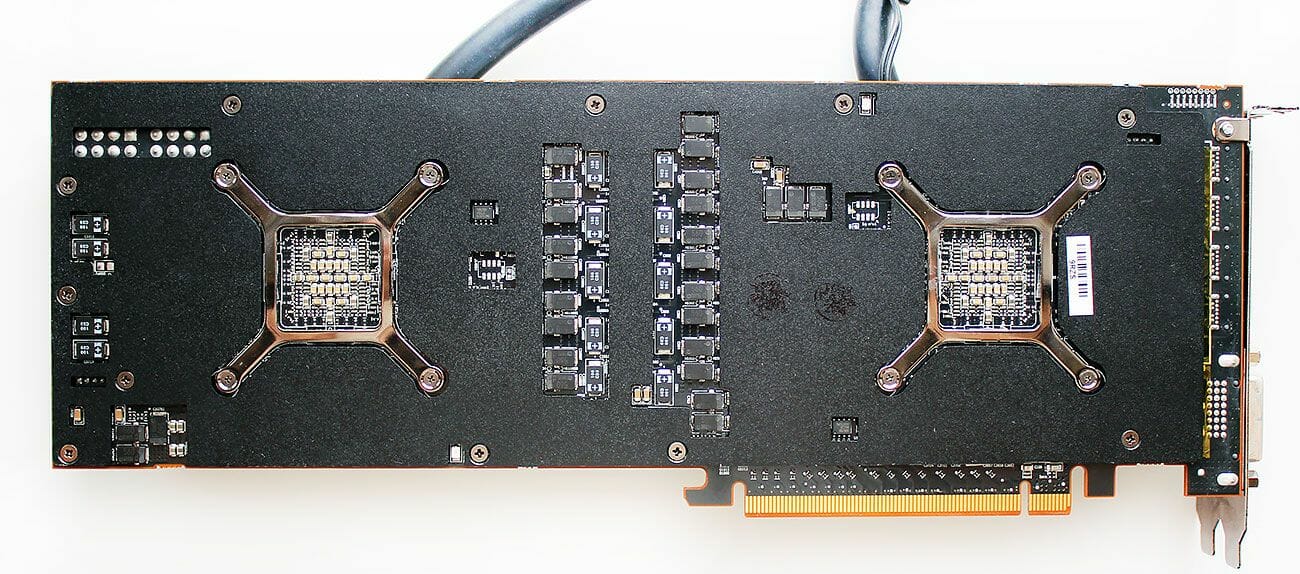
The reverse side of the card is covered with a metal plate that only has small square openings opposite the GPUs and tantalum capacitors.
The edges of the cooler casing are perforated to let out the air from the fan. You can see the pipes of the liquid cooling system here.
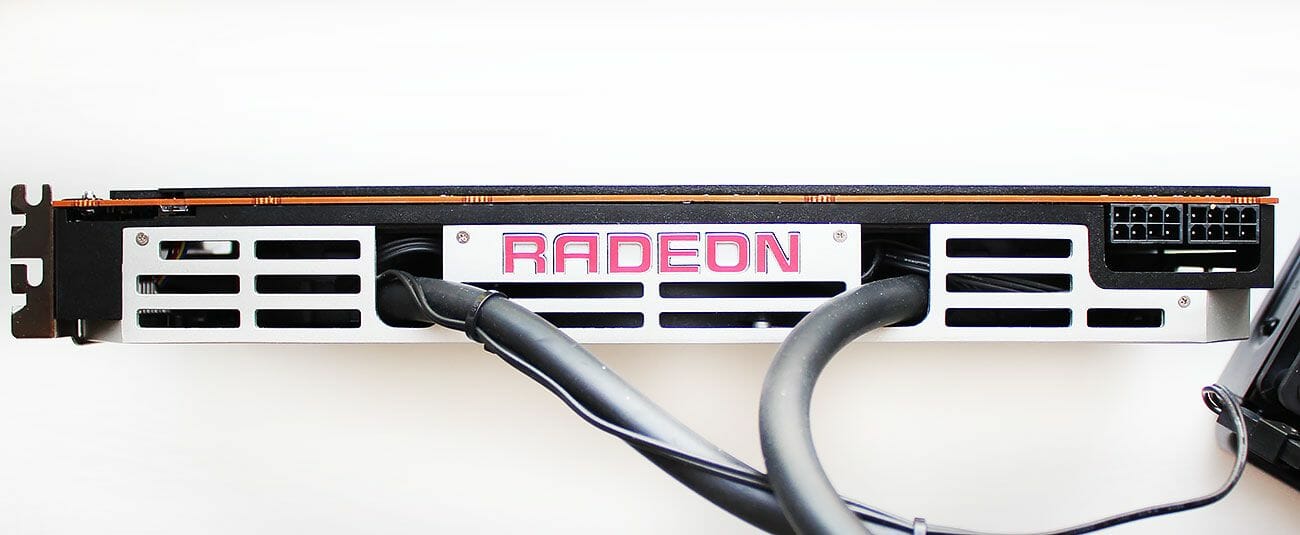
There are four mini-DisplayPorts (version 1.2) and one DVI connector on the card’s mounting bracket. Half of it is a vent grid.
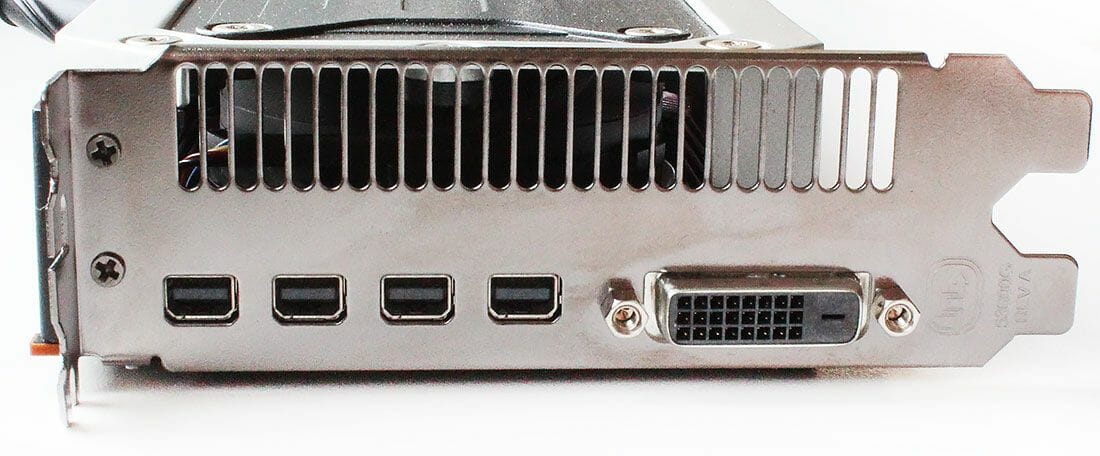
There is no CrossFireX connector, just like on the Radeon R9 290X/290. Graphics cards are now combined into multi-GPU configurations via the PCI Express interface.
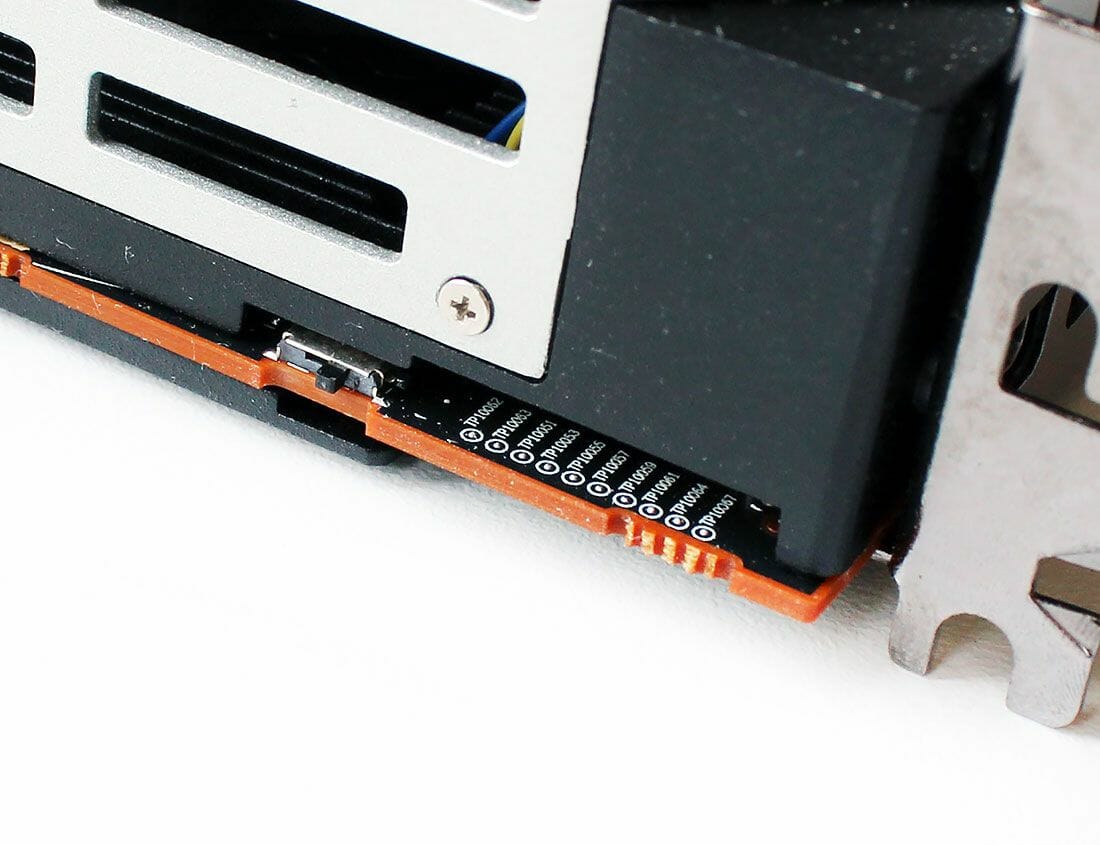
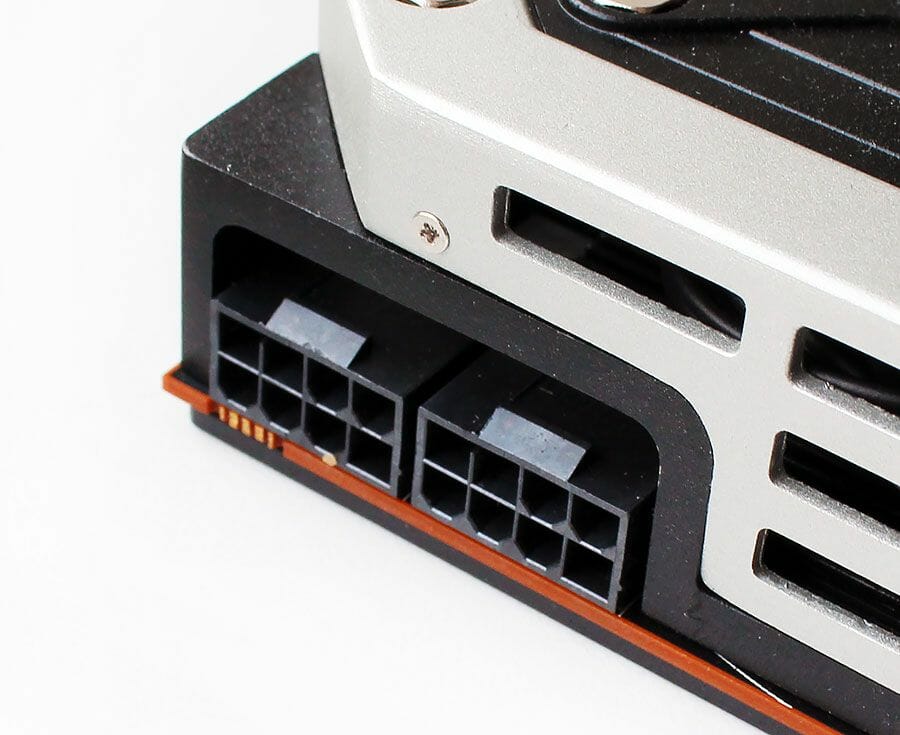
The AMD Radeon R9 295X2 is equipped with two 8-pin power connectors, each rated for up to 28 amperes.
AMD even published a special file with recommendations about the power supply the Radeon R9 295X2 needs, naming specific PSU models. The graphics card is specified to consume up to 500 watts. An 850-watt or higher PSU is recommended for it.
The next photo gives you some notion about the card’s design.
So, it consists of a PCB, a slim metal back cover, a heat-spreader with waterblocks and a casing with fan. The casing is secured with screws and can be removed easily. Under it, we can find two waterblocks with pumps on the GPUs, a copper heatsink in between, and a heat-spreading plate.
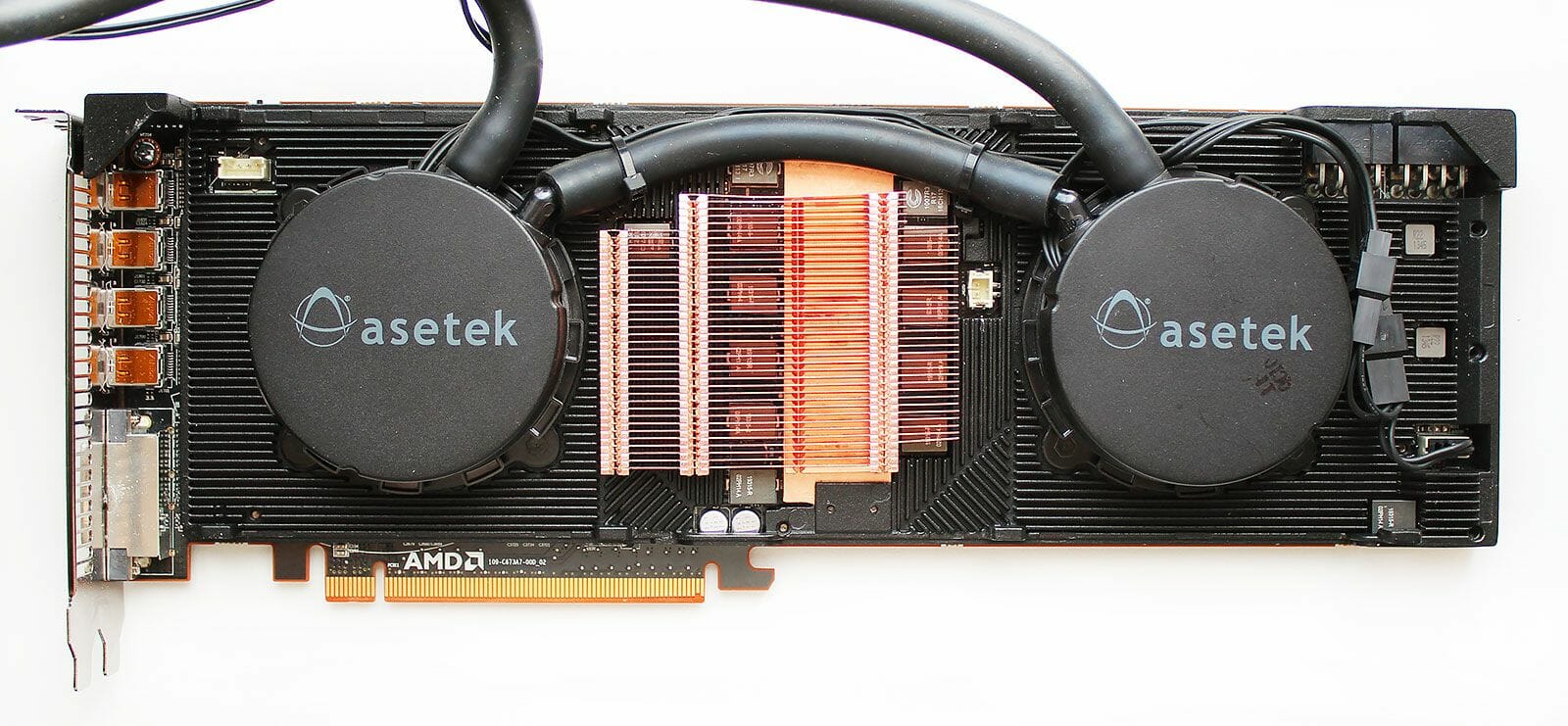
After removing the waterblocks, we see GPUs with too much thermal grease on them.
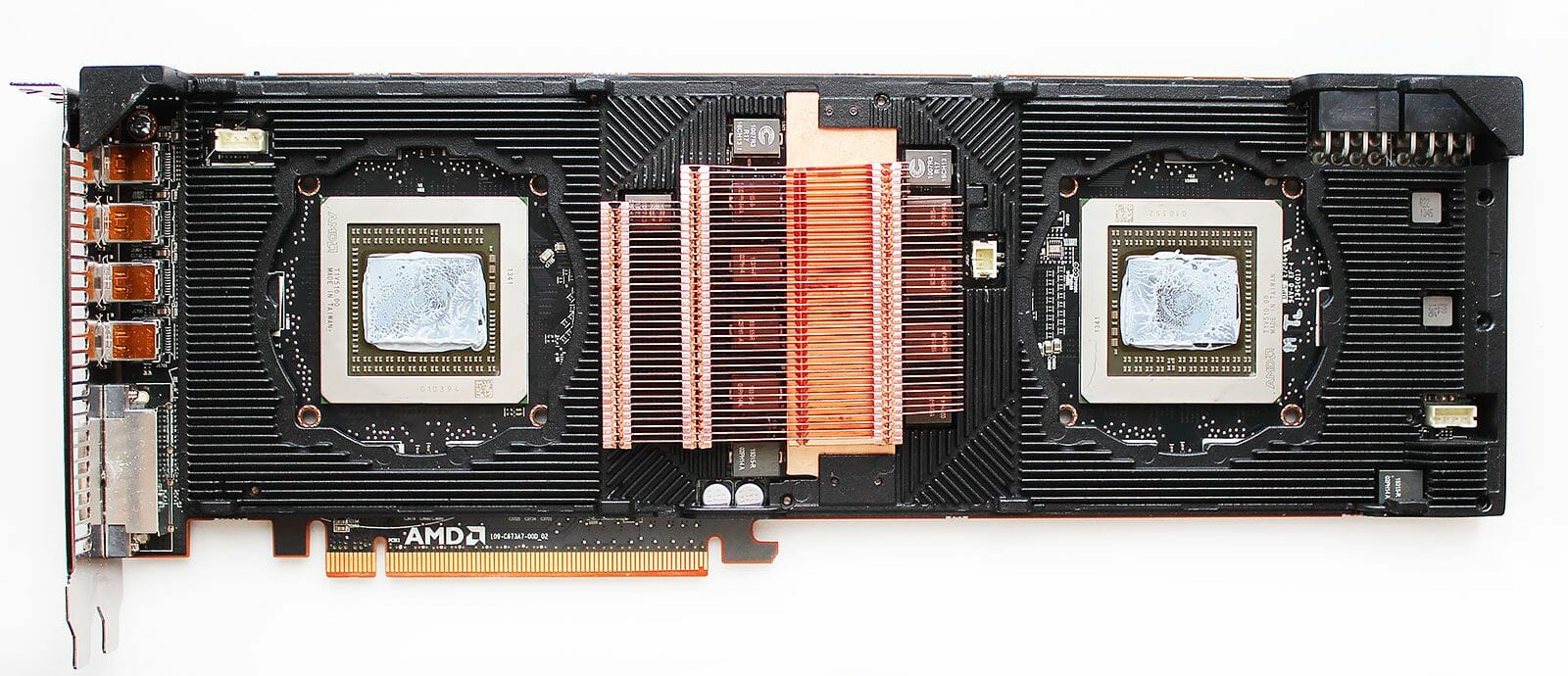
We didn’t remove the heat-spreading plate as we wanted to keep the thermal pads in their places. But judging by the photos from the official presentation, each GPU has a 5-phase power system with one additional phase for the graphics memory and PLL each. The power systems are managed by ON Semiconductor controllers and you can see additional tantalum capacitors on the reverse side of the PCB.
The two 28nm Hawaii XT GPUs communicate via a PLX 8747 controller that supports 48 PCIe lanes. They were both manufactured in Taiwan on the 41st week of 2013 (in the first half of October). Each GPU die is 438 sq. mm large and incorporates 6.2 billion transistors.
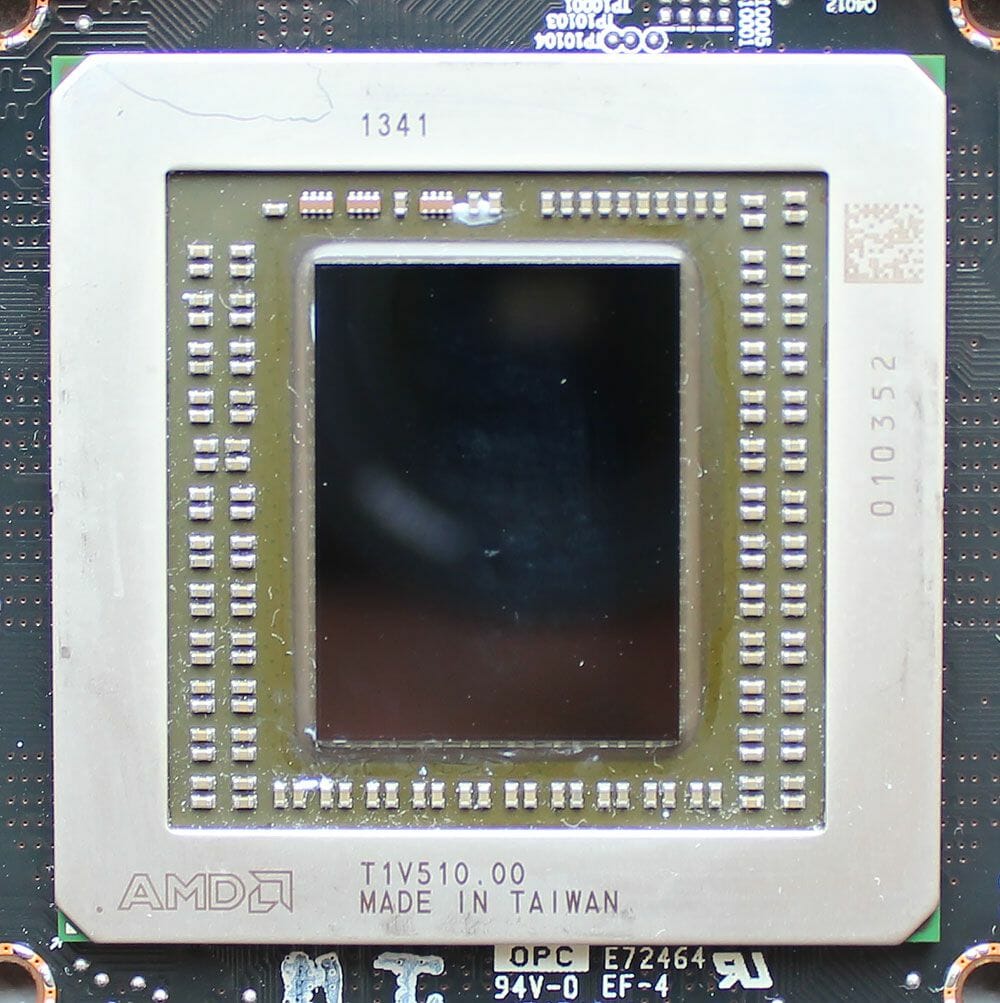
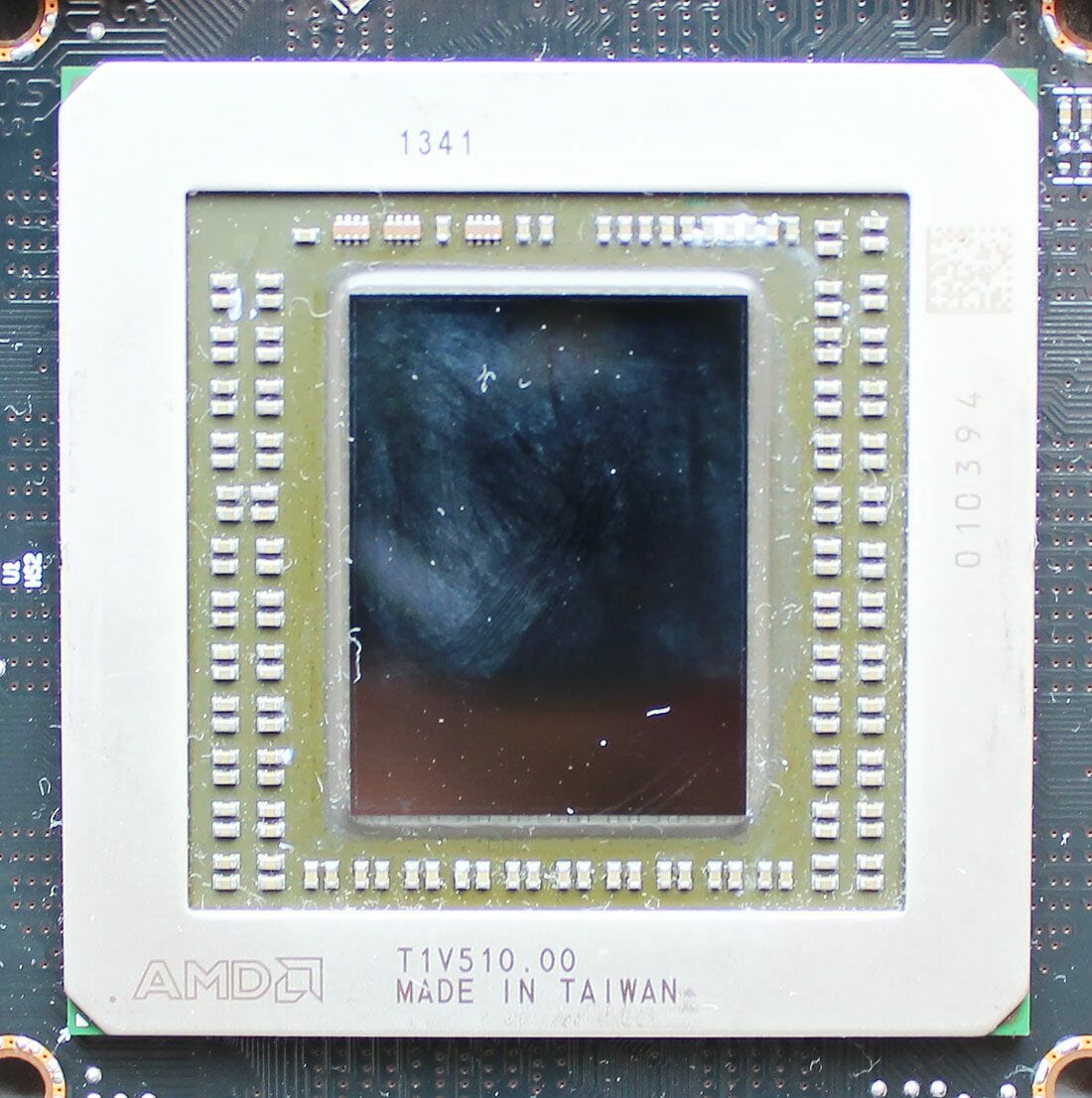
The AMD Radeon R9 295X2 carries two full-featured Hawaii XT GPUs with GCN architecture, each with 2816 unified shader processors, 176 texture-mapping units and 64 raster operators. The peak 3D clock rate of the GPUs is 1018 MHz, which is 18 MHz higher compared to the Radeon R9 290X. Theoretically, the Radeon R9 295X2 may be more than twice as fast as one R9 290X provided that CrossFireX technology shows its best.
In 2D applications the GPU clock rate is dropped to 300 MHz and the voltage is reduced, too. The ASIC Quality of the two GPU chips is 71.8% and 73.3%.
The AMD Radeon R9 295X2 is equipped with 4 gigabytes of graphics memory per each GPU. Like with every other dual-processor card, each GPU uses its dedicated memory bank, so the memory amount should be specified as 2x4GB. The 16 chips of GDDR5 memory surround the GPUs on both sides of the PCB. They are clocked at 5000 MHz in 3D applications. The peak memory bandwidth is 320 GB/s as confirmed by the GPU-Z utility.
The graphics card has one main and one backup BIOS chip. Both chips contain the same BIOS code.
And now let’s check out the cooling system installed on the AMD Radeon R9 295X2.
Cooling System: Efficiency and Noise Level
The AMD Radeon R9 295X2 is equipped with a liquid cooling system which is based on the Asetek platform (we guess it is the 550LC model). It includes an aluminum radiator with a 120mm fan.
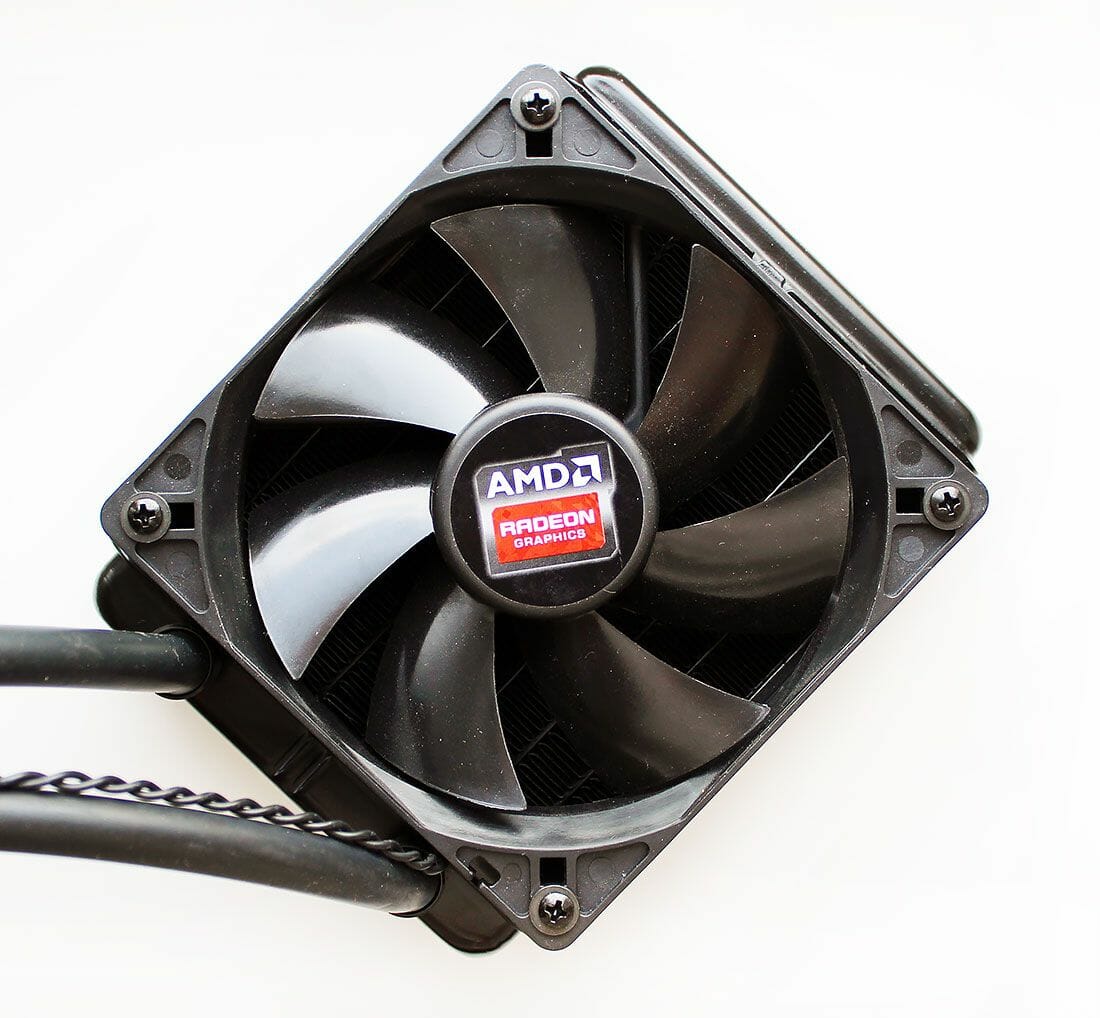
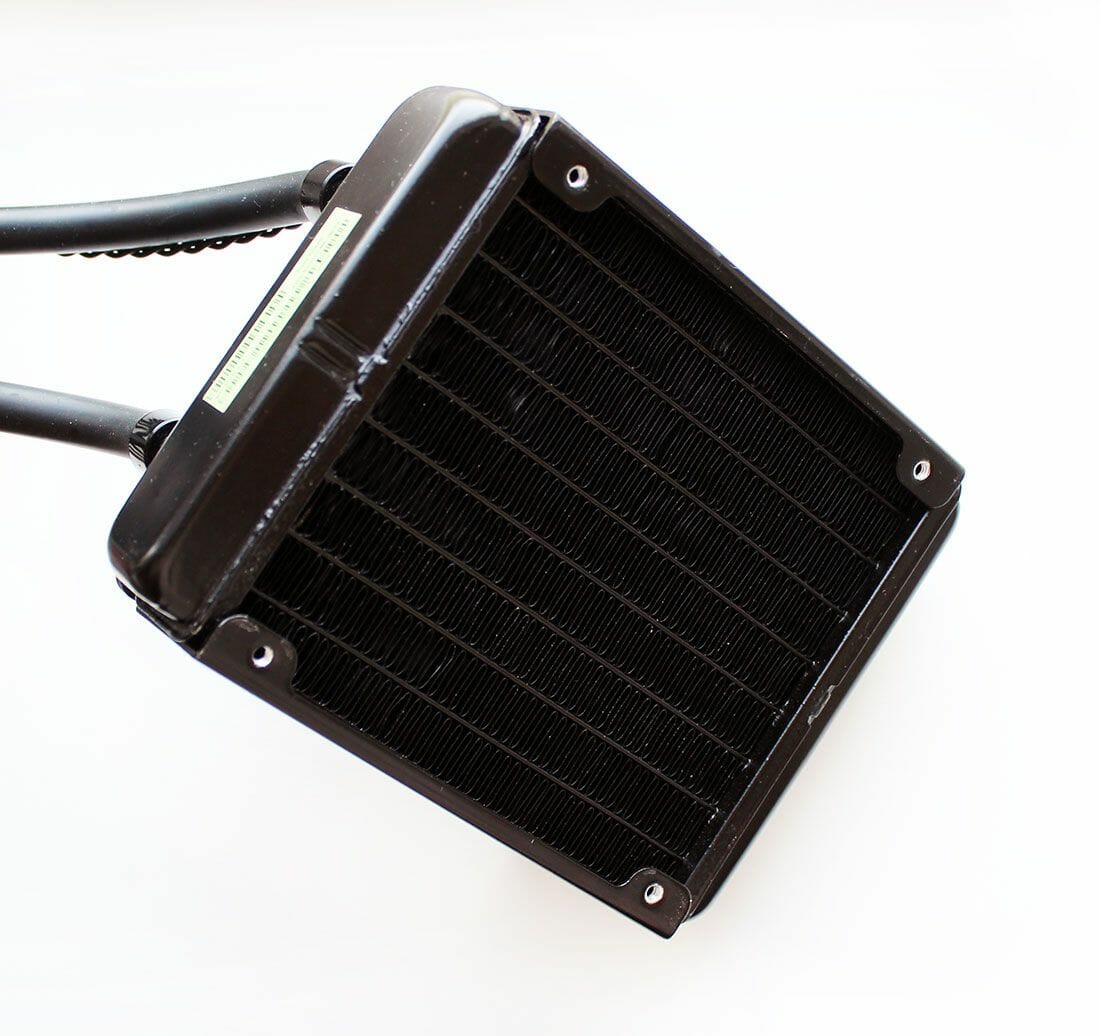
Two rubber pipes (about 400 mm long and 10 mm in diameter) are press-fitted onto the radiator’s nozzles.
The radiator is 38 mm thick, which is about twice as thick as Asetek’s cheapest and thinnest models, so we guess that installing a second fan on it might help drop the temperature down by a few degrees more and lower the noise level along the way.
There’s a pump mounted on each GPU, featuring a copper waterblock with microchannel design.
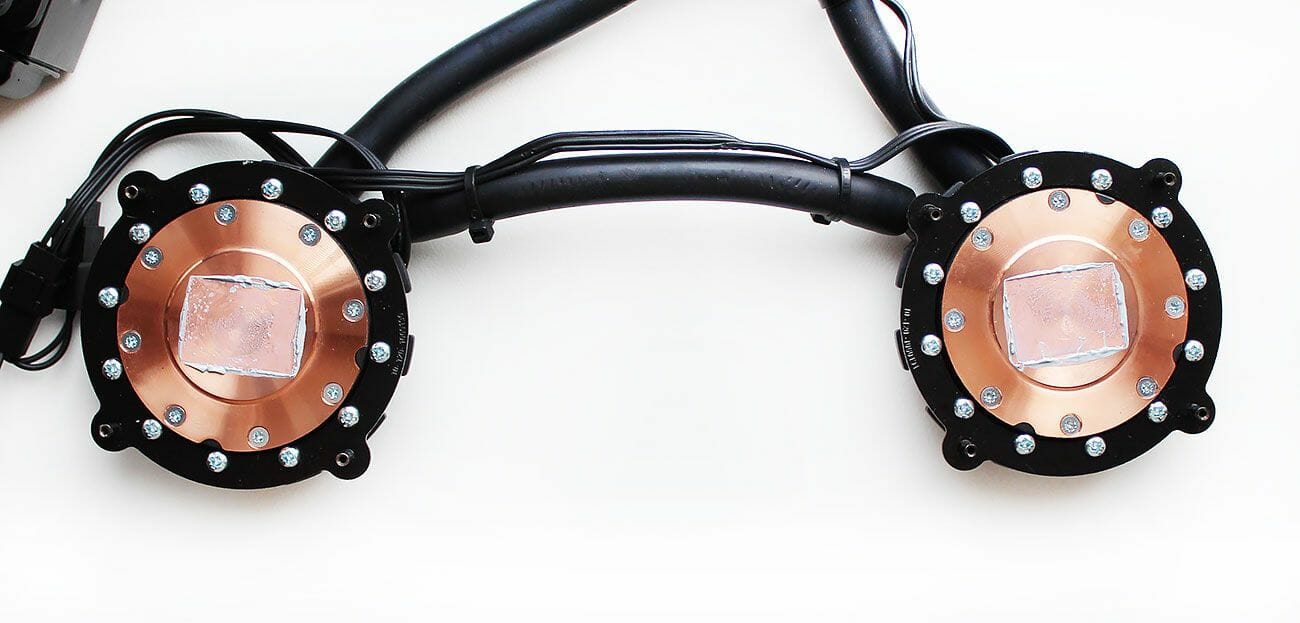
The pumps are connected sequentially, so one GPU is going to be somewhat hotter than another. We don’t know the specified output power of the pumps but they are absolutely silent at work. There are round depressions in the bases of the waterblocks for GPU dies.
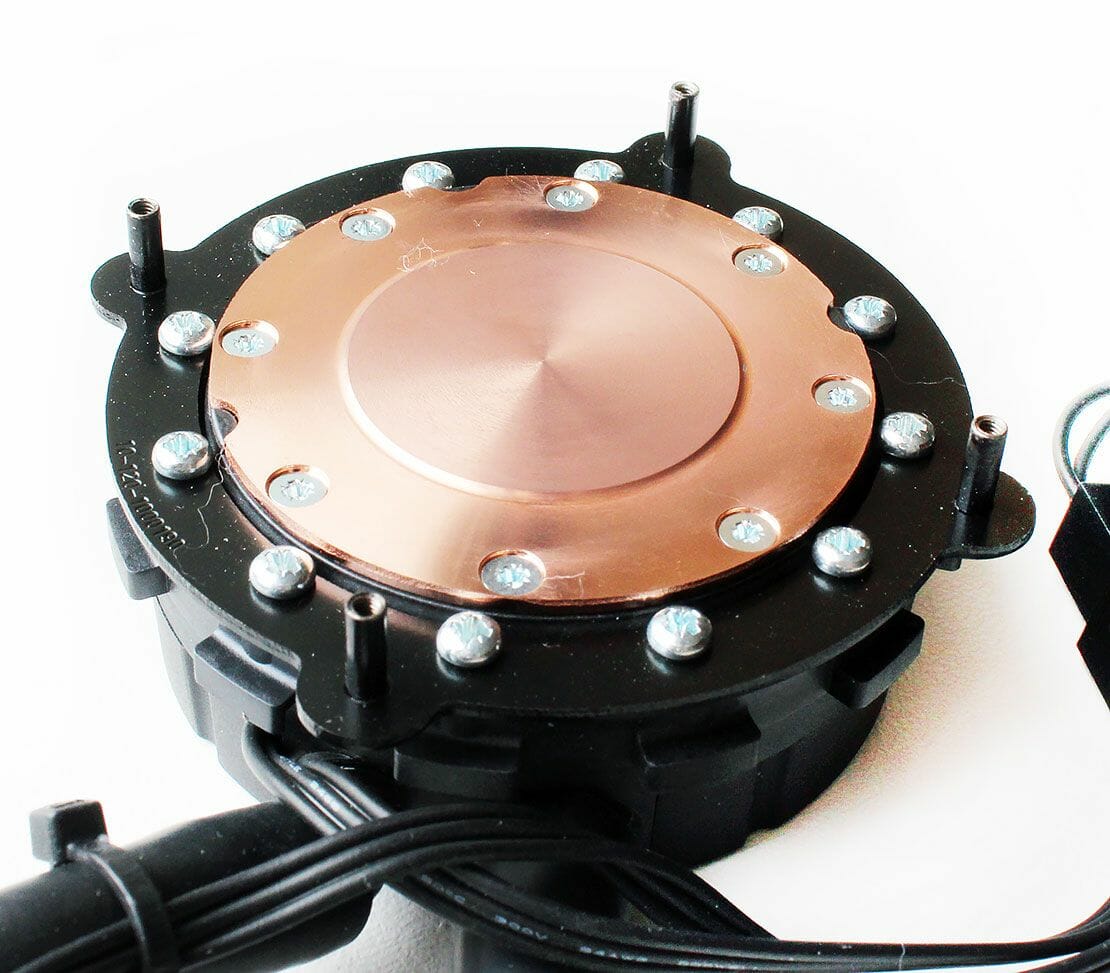
The face-side memory chips are cooled by a steel plate with low-profile finning. There’s a copper heatsink on the power transistors.
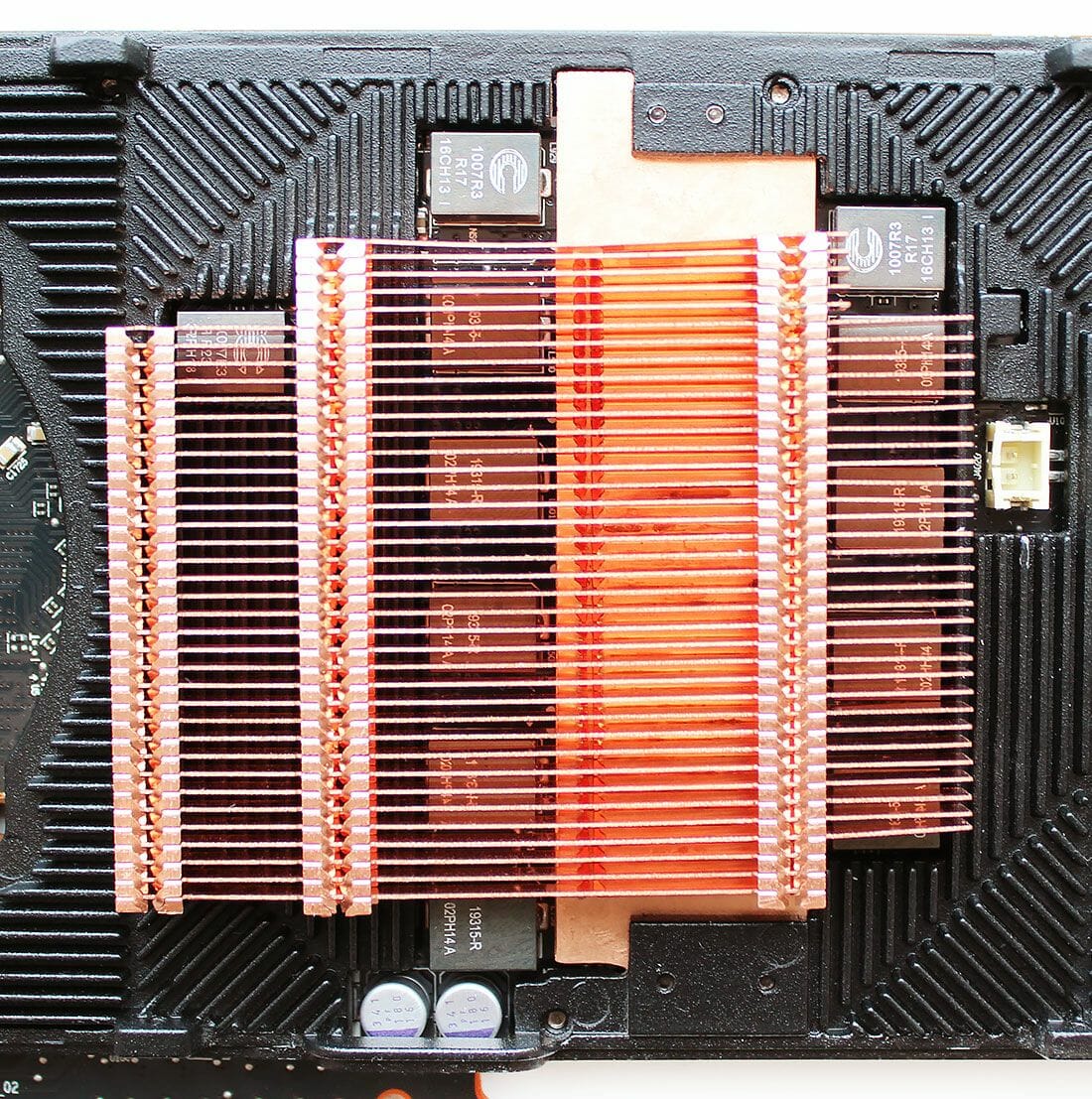
Like the PCB itself, it is cooled by the central fan.
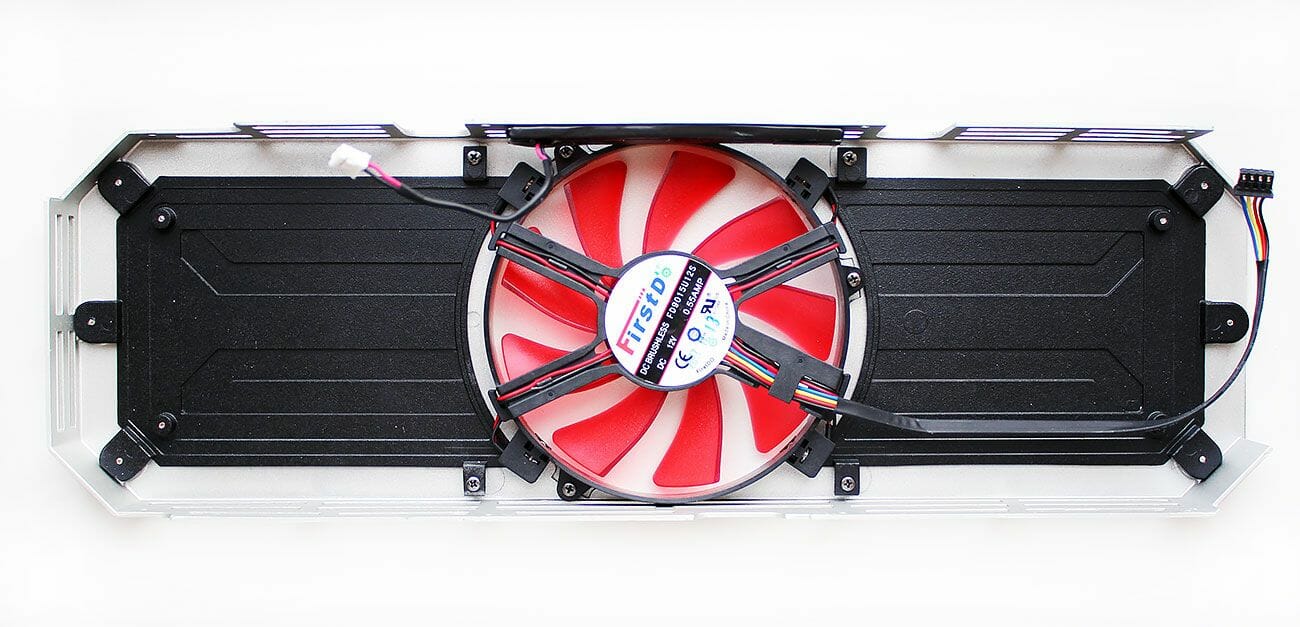
The fan is 85 mm in diameter. Its speed is PWM-regulated but we couldn’t monitor it using our software tools.
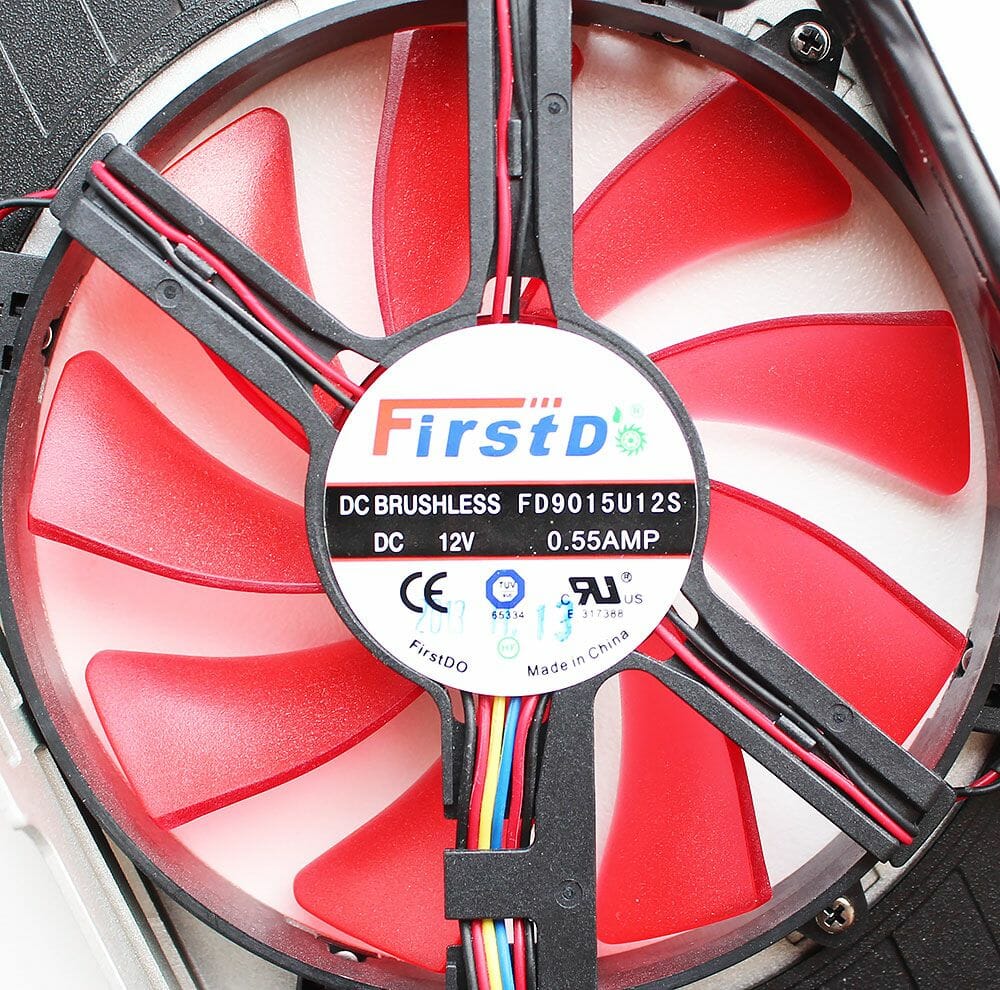
The fan has four LEDs and is highlighted in red.
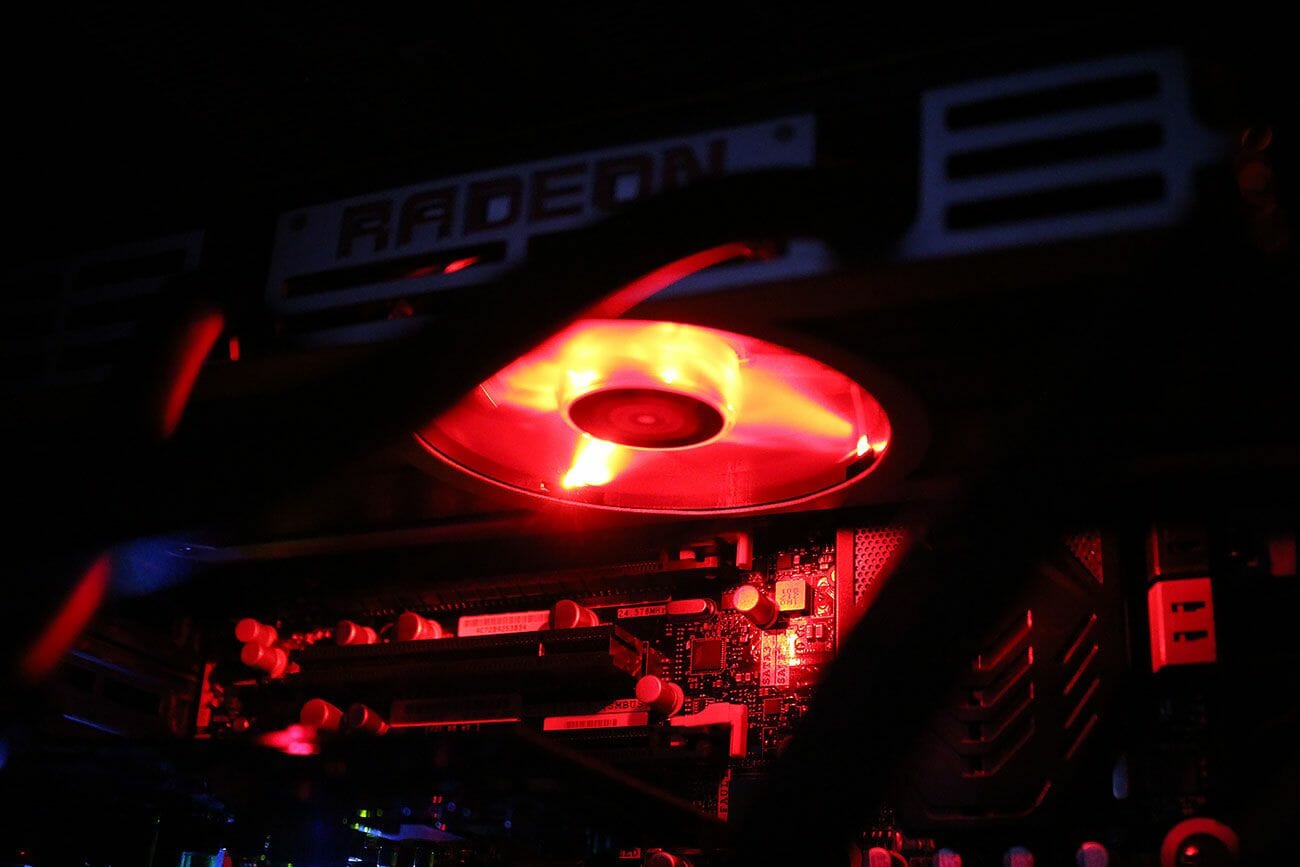
The word “RADEON” on the cooler casing should be highlighted as well, but this highlighting didn’t work on our sample of the card.
To measure the temperature of our Radeon R9 295X2 we ran Aliens vs. Predator (2010) five times at the maximum visual quality settings, at a resolution of 2560×1440 pixels, with 16x anisotropic filtering and with 4x MSAA.
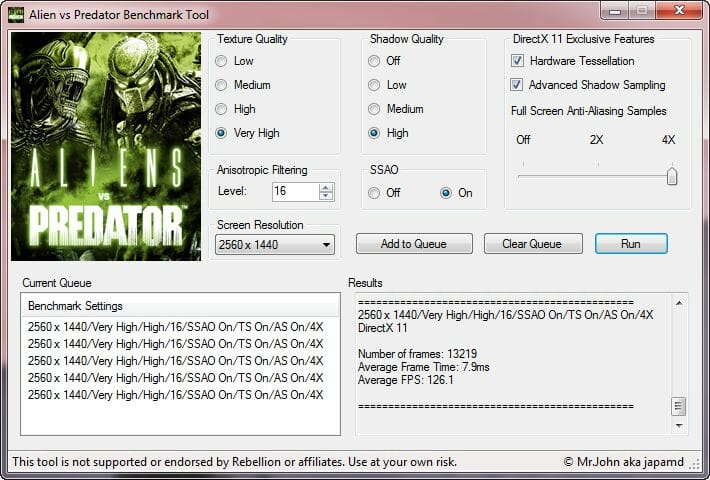
We used MSI Afterburner 3.0.0 beta 19 and GPU-Z version 0.7.8 to monitor temperatures and other parameters. We didn’t install the graphics card’s radiator inside our computer case because we would have had to use one more 120mm fan and thus help the cooler with its work. Of course, the open computer case aids the cooler too, but not as much as two fans installed on the radiator would have helped.
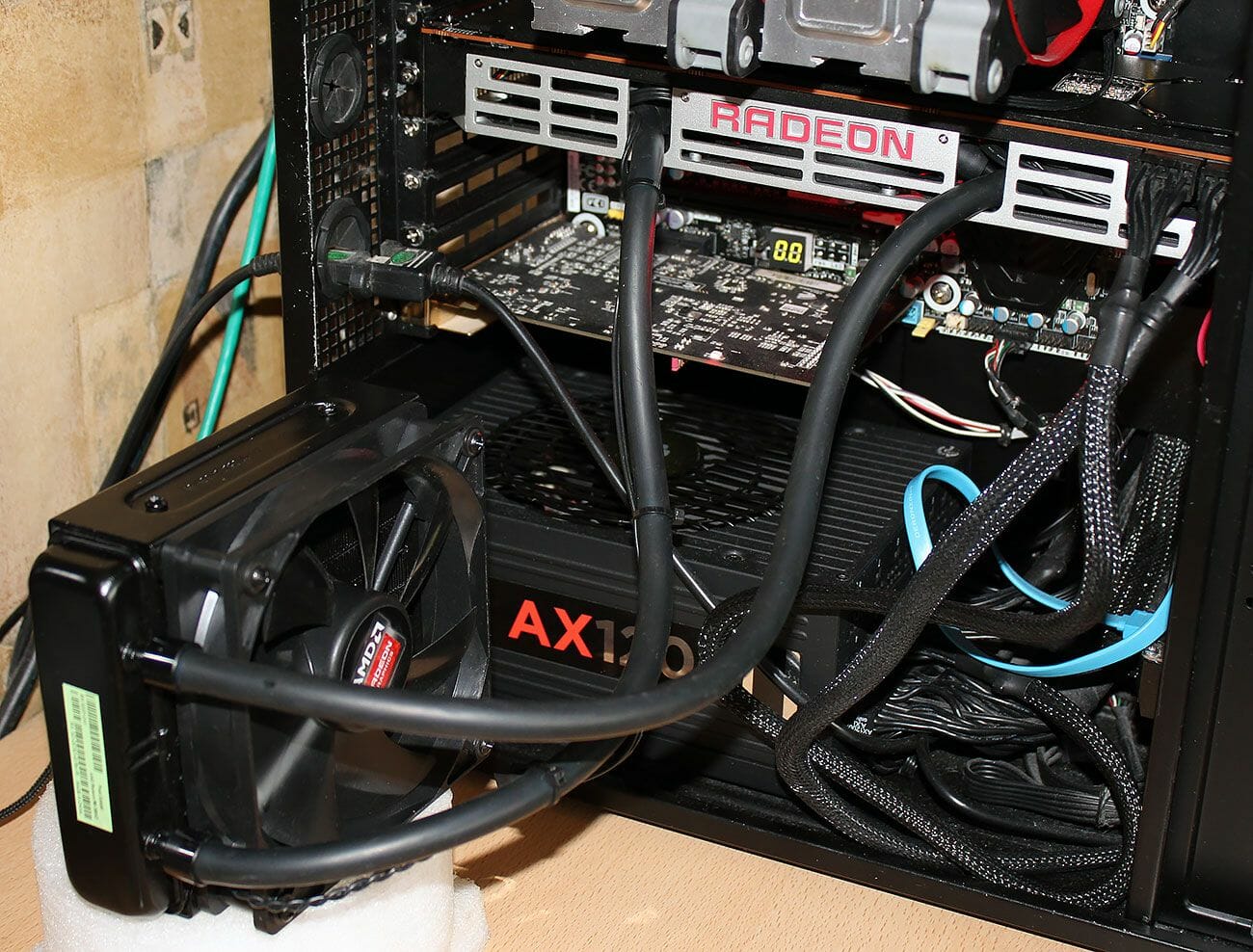
We can add that the room temperature was 25°C during our tests. Let’s see how efficient the cooler is with its fans regulated automatically.
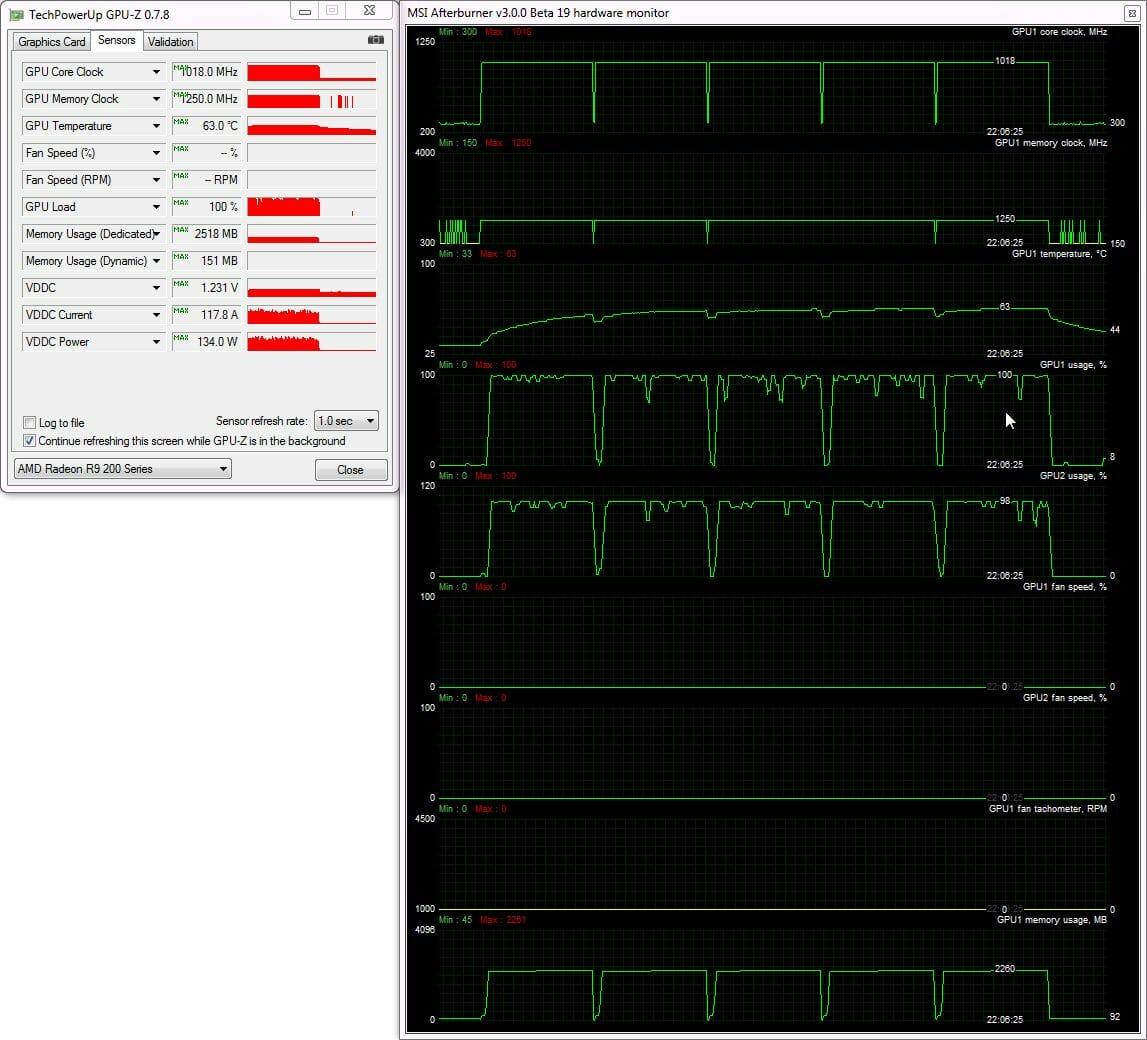
As you can see, the liquid cooling system copes well with its job, keeping one GPU as cold as 63°C. Unfortunately, the temperature of the other GPU is not monitored, yet even if it’s higher by 5°C, the result is just excellent for a graphics card with a heat dissipation of 500 watts.
We can remind you that reference Radeon R9 290X and 290 cards quickly reach a GPU temperature of 94-95°C and then have to drop their GPU clock rate, provoking a performance hit. Even though the liquid cooling system is a forced solution, it does work well here, also in terms of the noise level. The fan on the radiator is inaudible even when you install the latter outside your computer case. And the fan on the graphics card itself only gets noisy under continuous 3D load. The AMD Radeon R9 295X2 is not quiet, yet it seems to be subjectively much quieter than the reference Radeon R9 290X/290 or GeForce GTX 780/780 Ti.
Overclocking
Practice suggests that dual-processor graphics cards generally have low overclocking potential. Today we’ve got a leading solution of this kind with a power draw of 500 watts but the high-performance liquid cooling system does give us some hope for good overclocking. Indeed, we managed to speed up the GPUs by 67 MHz (+6.6%) and the graphics memory by 760 MHz (+13.2%).
The resulting clock rates were 1085/5760 MHz.
The liquid cooling system coped with the overclocked Radeon R9 295X2 easily. The peak GPU temperature was only 65°C, so we didn’t have to worry about GPU throttling.
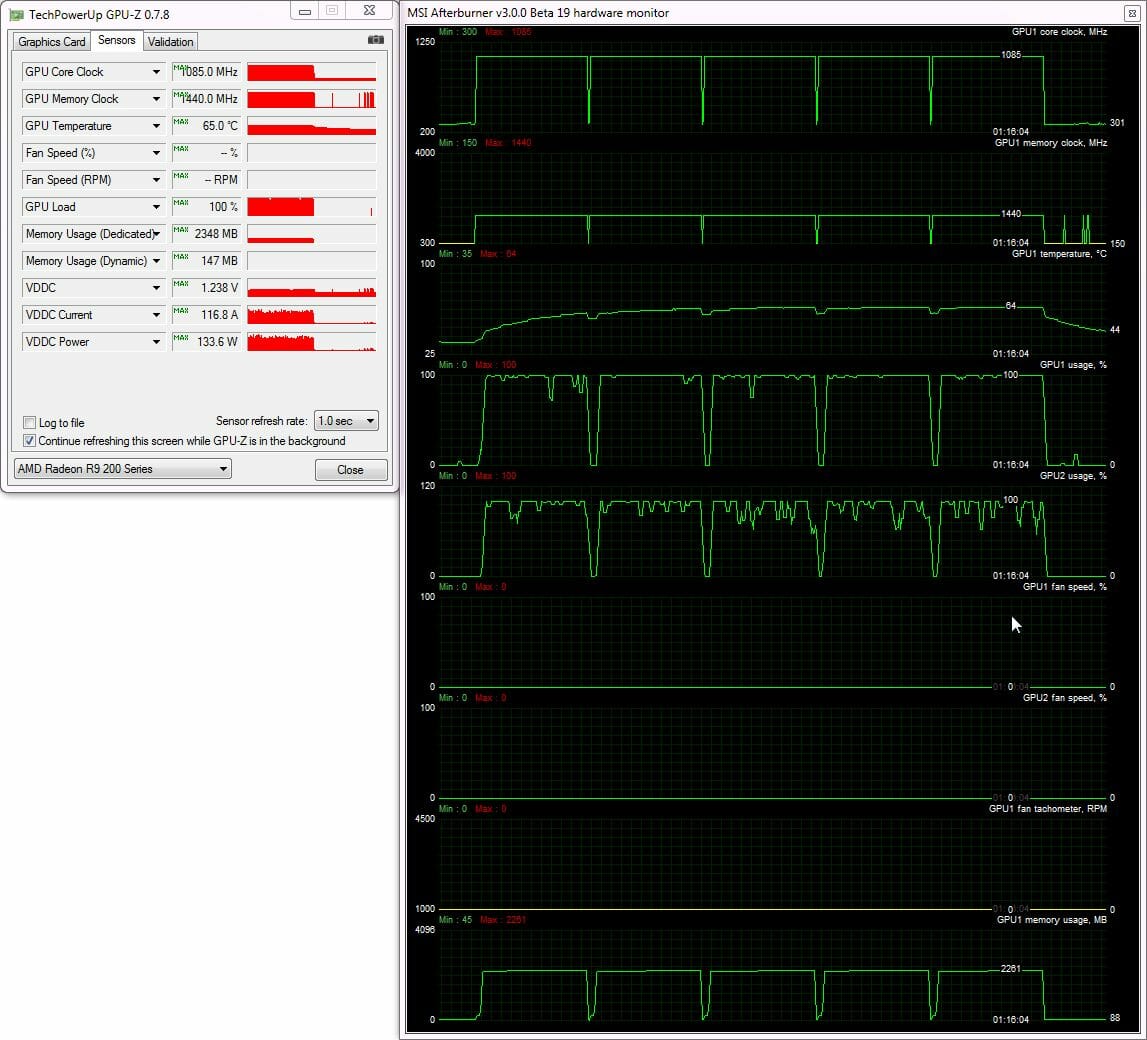
We guess the liquid cooling system is a clever and adequate solution, even though it makes you look for a place for its 120mm radiator inside your computer case. And you can increase its efficiency even more by mounting not one but two fans on the radiator!
Testbed and Methods
Here is the list of components we use in our testbed.
- Mainboard: Intel Siler DX79SR (Intel X79 Express, LGA2011, BIOS 0594 dated 06.08.2013)
- CPU: Intel Core i7-3970X Extreme Edition 3.5/4.0 GHz (Sandy Bridge-E, C2, 1.1 V, 6x256KB L2 cache, 15MB L3 cache)
- CPU cooler: Phanteks PH-TC14PЕ (2xCorsair AF140 fans, 900 RPM)
- Thermal grease: ARCTIC MX-4
- Graphics cards:
- AMD Radeon R9 295X2 (2x4GB, 1018/5000 MHz)
- AMD Radeon HD 7990 (2x3GB, 1000/6000 MHz)
- AMD Radeon R9 290X (4GB, 1000/5000 MHz)
- Nvidia GeForce GTX 690 (2x2GB, 915-1019/6008 MHz)
- Zotac GeForce GTX Titan Black (6GB, 889-980/7000 MHz and 1064-1155/8120 MHz)
- System memory: DDR3 4x8GB G.SKILL TridentX F3-2133C9Q-32GTX (XMP: 2133 MHz, 9-11-11-31, 1.6 volts)
- System disk: SSD 256GB Crucial m4 (SATA 6 Gbit/s, CT256M4SSD2, BIOS v0009)
- Games/software disk: Western Digital VelociRaptor (SATA-2, 300 GB, 10000 RPM, 16 MB cache, NCQ) in a Scythe Quiet Drive 3.5″ enclosure
- Backup disk: Samsung Ecogreen F4 HD204UI (SATA-2, 2 TB, 5400 RPM, 32 MB cache, NCQ)
- Sound card: Auzen X-Fi HomeTheater HD
- Computer case: Antec Twelve Hundred (front panel: three Noiseblocker NB-Multiframe S-Series MF12-S2 fans at 1020 RPM; back panel: two Noiseblocker NB-BlackSilentPRO PL-1 fans at 1020 RPM; top panel: one preinstalled 200mm fan at 400 RPM)
- Control & monitoring panel: Zalman ZM-MFC3
- Power supply: Corsair AX1200i (1200 W), 120mm fan
- Monitor: 27″ Samsung S27A850D (DVI-I, 2560×1440, 60 Hz)
We will compare the new card with the dual-processor solutions AMD Radeon HD 7990 2x3GB and Nvidia GeForce GTX 690 2x2GB working at their default clock rates.
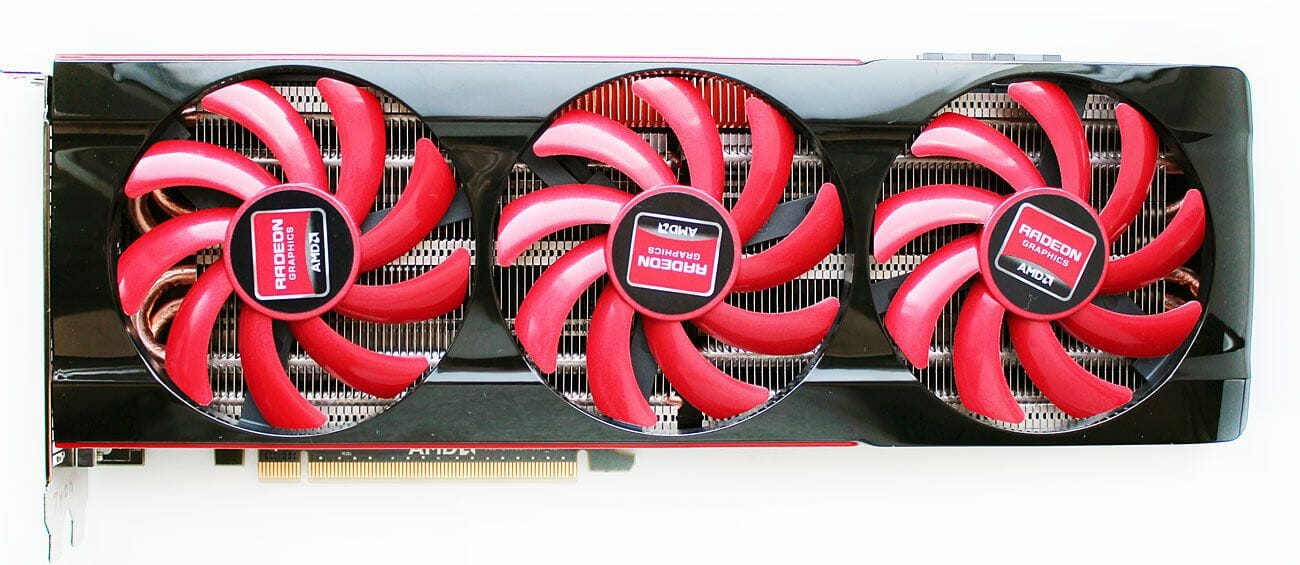
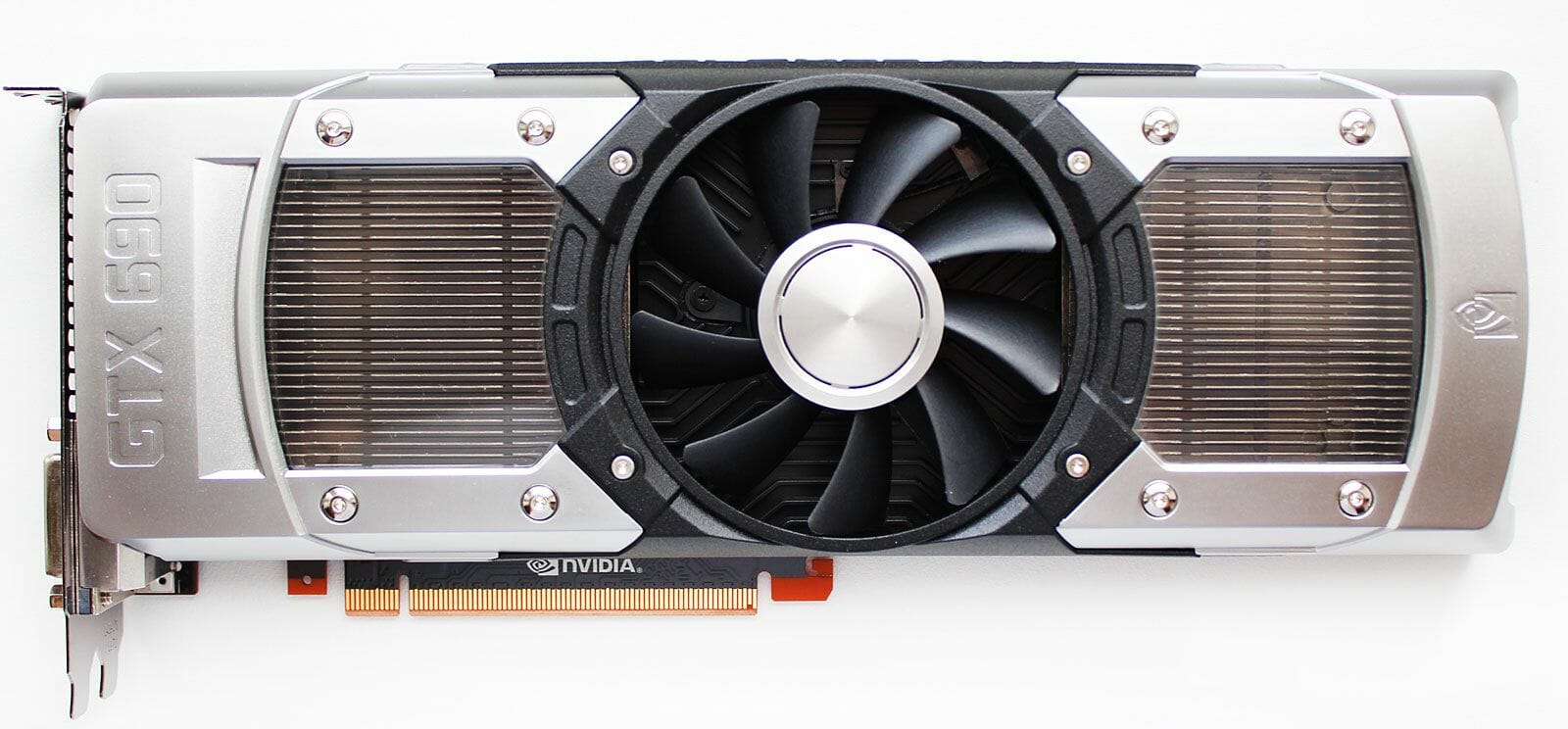
We will also include the two fastest single-processor cards AMD Radeon R9 290X 4GB (at its default clock rates) and Zotac GeForce GTX Titan Black 6GB (at the default clock rates and in overclocked mode).
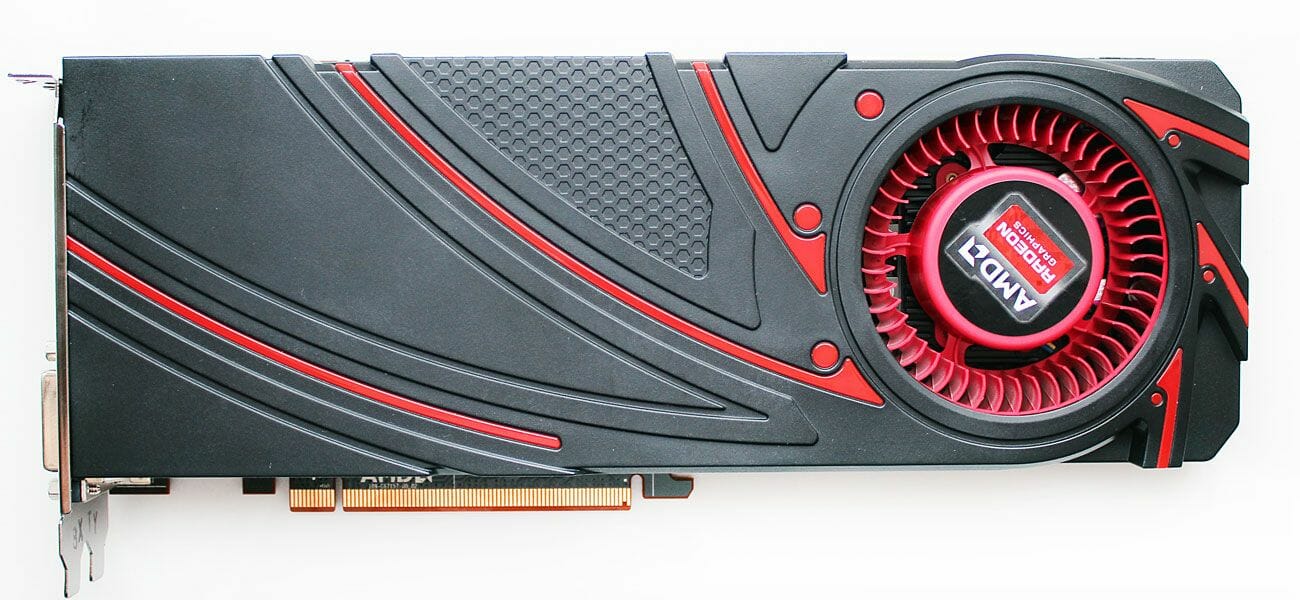
The Zotac is overclocked to 1064-1155/8120 MHz. It is priced like the dual-processor Nvidia GeForce GTX 690 ($999), so we want to know if the current single-processor flagship can catch up with the dual-processor flagship card of the previous generation. The Power Limit is set at its maximum for each graphics card.
In order to lower the dependence of the graphics cards’ performance on the overall platform speed, we overclocked our 32nm six-core CPU to 4.8 GHz by setting its frequency multiplier at x48 and enabling Load-Line Calibration. The CPU voltage was increased to 1.385 volts in the mainboard’s BIOS.
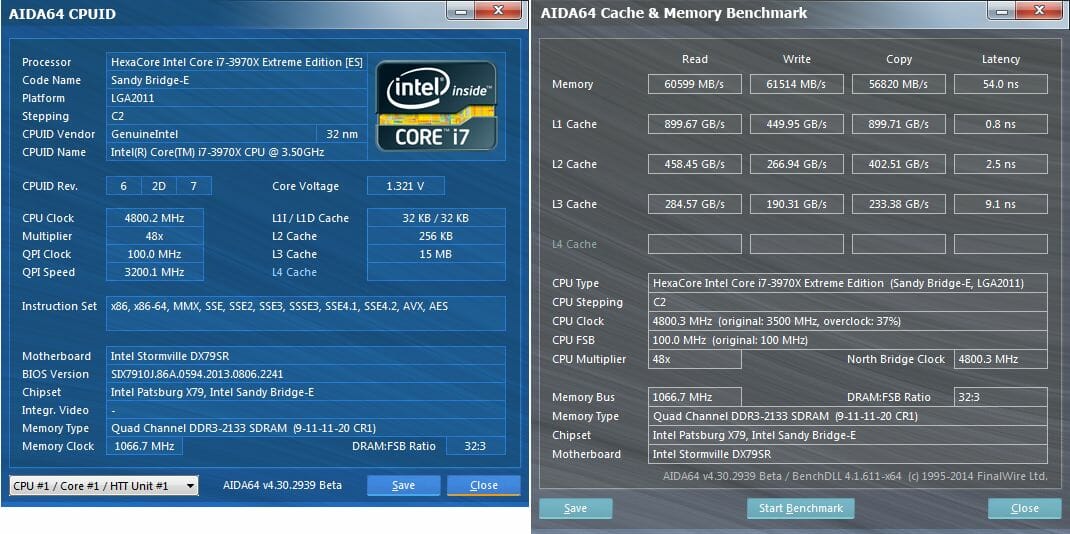
Hyper-Threading was turned on. We used 32 GB of system memory at 2.133 GHz with timings of 9-11-11-20_CR1 and voltage of 1.6125 volts.
The testbed ran Microsoft Windows 7 Ultimate x64 SP1 with all critical updates installed. We used the following drivers:
- Intel Chipset Drivers – 9.4.4.1006 WHQL dated 21.09.2013
- DirectX End-User Runtimes, dated 30 November 2010
- AMD Catalyst 14.6 Beta (14.100.0.0) dated 27.05.2014
- Nvidia GeForce 337.88 WHQL dated 26.05.2014
We benchmarked the graphics cards’ performance at two display resolutions: 1920×1080 and 2560×1440 pixels. There were two visual quality modes: “Quality+AF16x” means the default texturing quality in the drivers + 16x anisotropic filtering whereas “Quality+ AF16x+MSAA 4x(8x)” means 16x anisotropic filtering and 4x or 8x antialiasing. In some games we use antialiasing algorithms other than MSAA as indicated below and in the diagrams. We enabled anisotropic filtering and full-screen antialiasing from the game’s menu. If the corresponding options were missing, we changed these settings in the Control Panels of the Catalyst and GeForce drivers. We also disabled V-Sync there. There were no other changes in the driver settings.
The graphics cards were tested in two benchmarks and 14 games updated to the latest versions.
- 3DMark (2013) (DirectX 9/11) version 1.2.250.0: Cloud Gate, Fire Strike and Fire Strike Extreme scenes.
- Unigine Valley Bench (DirectX 11) version 1.0: Maximum visual quality settings, 16x AF and/or 4x MSAA, 1920×1080.
- Total War: SHOGUN 2 – Fall of the Samurai (DirectX 11) version 1.1.0: integrated benchmark (the Sekigahara battle) with maximum visual quality settings and 8x MSAA.
- Sniper Elite V2 Benchmark (DirectX 11) version 1.05: Adrenaline Sniper Elite V2 Benchmark Tool v1.0.0.2 BETA with maximum graphics quality settings (“Ultra” profile), Advanced Shadows: HIGH, Ambient Occlusion: ON, Stereo 3D: OFF, Supersampling: OFF, two sequential runs of the test.
- Sleeping Dogs (DirectX 11) version 1.5: Adrenaline Sleeping Dogs Benchmark Tool v1.0.2.1 with maximum image quality settings, Hi-Res Textures pack installed, FPS Limiter and V-Sync disabled, two consecutive runs of the built-in benchmark with quality antialiasing at Normal and Extreme levels.
- Hitman: Absolution (DirectX 11) version 1.0.447.0: built-in test with Ultra settings, enabled tessellation, FXAA and global lighting.
- Crysis 3 (DirectX 11) version 1.2.0.1000: maximum visual quality settings, Motion Blur – Medium, lens flares – on, FXAA and MSAA 4x, two consecutive runs of a scripted scene from the beginning of the “Swamp” mission (110 seconds long).
- Tomb Raider (2013) (DirectX 11) version 1.1.748.0: we used Adrenaline Benchmark Tool, all image quality settings set to “Ultra”, V-Sync disabled, FXAA and 2x SSAA antialiasing enabled, TessFX technology activated, two consecutive runs of the in-game benchmark.
- BioShock Infinite (DirectX 11) version 1.1.25.5165: we used Adrenaline Action Benchmark Tool with “Ultra” and “Ultra+DOF” quality settings, two consecutive runs of the in-game benchmark.
- Metro: Last Light (DirectX 11) version 1.0.0.15: we used the built-in benchmark for two consecutive runs of the D6 scene. All image quality and tessellation settings were at “Very High”, Advanced PhysX technology enabled, with and without SSAA antialiasing.
- GRID 2 (DirectX 11) version 1.0.85.8679: we used the built-in benchmark, the visual quality settings were all at their maximums, the tests were run with and without MSAA 8x antialiasing with eight cars on the Chicago track.
- Company of Heroes 2 (DirectX 11) version 3.0.0.13553: two consecutive runs of the integrated benchmark at maximum image quality and physics effects settings.
- Total War: Rome II (DirectX 11) version 1.11.0.0: Extreme quality, V-Sync disabled, SSAA enabled, two consecutive runs of the integrated benchmark.
- Batman: Arkham Origins (DirectX 11) version 1.0 update 8: Ultra visual quality, V-Sync disabled, all the effects enabled, all DX11 Enhanced features enabled, Hardware Accelerated PhysX = Normal, two consecutive runs of the in-game benchmark.
- Battlefield 4 (DirectX 11) – version 111433: Ultra settings, two successive runs of a scripted scene from the beginning of the “Tashgar” mission (110 seconds long), with the Mantle API enabled for AMD-based cards.
- Thief (DirectX 11) version 1.5 build 4158.5: Maximum visual quality settings, Parallax Occlusion Mapping and Tessellation enabled, a double run of the in-game benchmark with the Mantle API enabled for AMD-based cards.
We publish the bottom frame rate for games that report it. Each test was run twice, the final result being the best of the two if they differed by less than 1%. If we had a larger difference, we reran the test at least once again to get repeatable results.
Performance
The results of the AMD Radeon R9 295X2 are colored lilac in the diagrams below. The dual-processor AMD Radeon HD 7990 and the AMD Radeon R9 290X are colored AMD’s traditional red. The color of the dual-processor Nvidia GeForce GTX 690 is turquoise whereas the results of the Zotac GeForce GTX Titan Black are marked in light green.
Since we’re testing the fastest graphics cards available today on the market, we will focus on the 2560×1440 resolution with various antialiasing methods. We guess that’s the settings that are likely to be used in games running on such advanced hardware.
3DMark (2013)
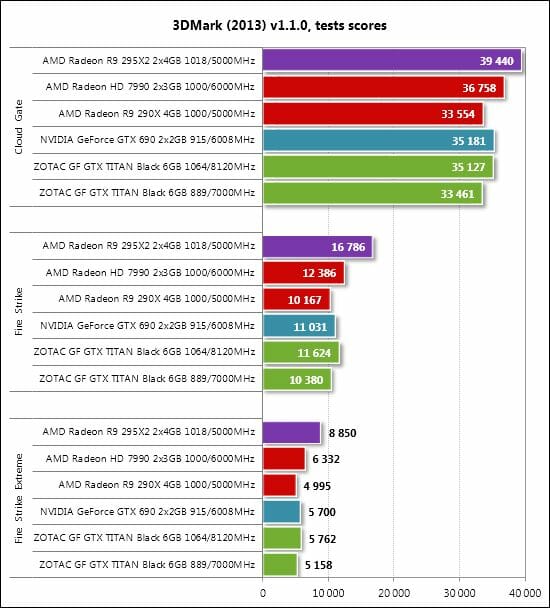
The AMD Radeon R9 295X2 delivers outstanding performance in the first test. It enjoys a 40% advantage over the second-best Radeon HD 7990 and beats the Radeon R9 290X by as much as 77%. And these are not even the best results in this test session as you will see below.
Apart from the least expensive Radeon R9 290X, the AMD-based solutions are ahead of their Nvidia-based opponents, including the overclocked Zotac GeForce GTX Titan Black. The latter beats the dual-processor Nvidia GeForce GTX 690, by the way.
Unigine Valley Bench
This benchmark shows us a different picture:
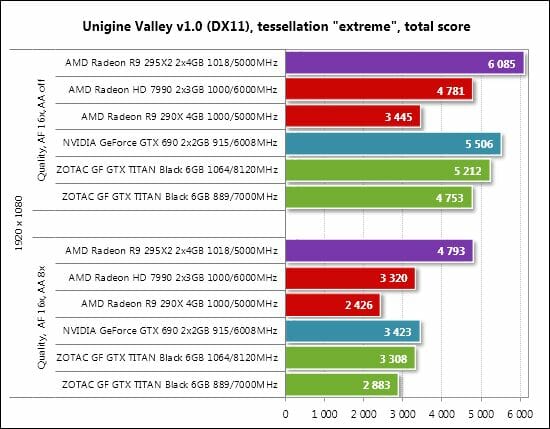
The AMD Radeon R9 295X2 is still brilliant, beating the Radeon R9 290X by 97.6% and the Radeon HD 7990 by 44.3%. The Radeon HD 7990 itself is somewhat slower than the Nvidia GeForce GTX 690, which in its turn is barely ahead of the overclocked Zotac GeForce GTX Titan Black. Although very expensive, Nvidia’s single-processor flagship is very fast indeed.
Total War: SHOGUN 2 – Fall of the Samurai
Nvidia is strong in this game, too.
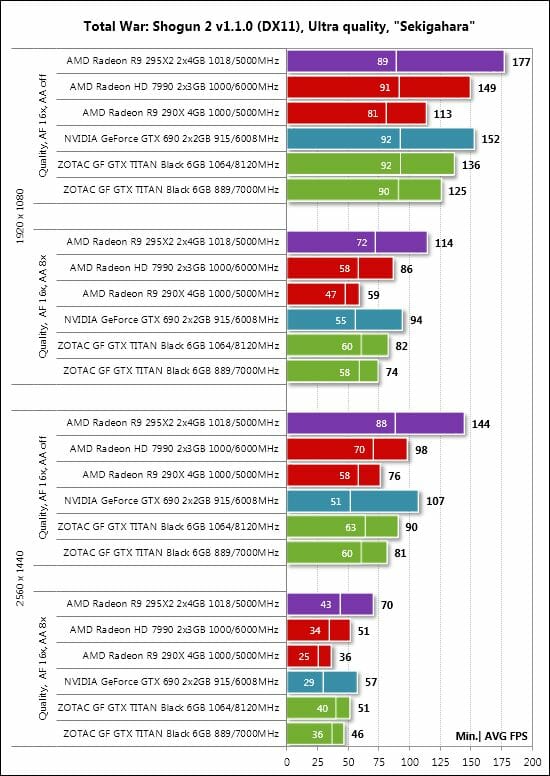
Anyway, the new AMD Radeon R9 295X2 has no rivals as yet. It’ll only have one when the GeForce GTX Titan starts selling. The Radeon R9 295X2 is an impressive 94.4% ahead of the Radeon R9 290X at the highest load (2560×1440 with 8x MSAA). The gap from the dual-processor Radeon HD 7990 is up to 47%, which is quite large, too. It is the Nvidia GeForce GTX 690 that takes second place in this benchmark as it beats the overclocked Zotac GeForce GTX Titan Black by up to 15.9%.
Sniper Elite V2 Benchmark
The Nvidia-based solutions perform well in this benchmark, yet the AMD Radeon R9 295X2 is in the lead, anyway.
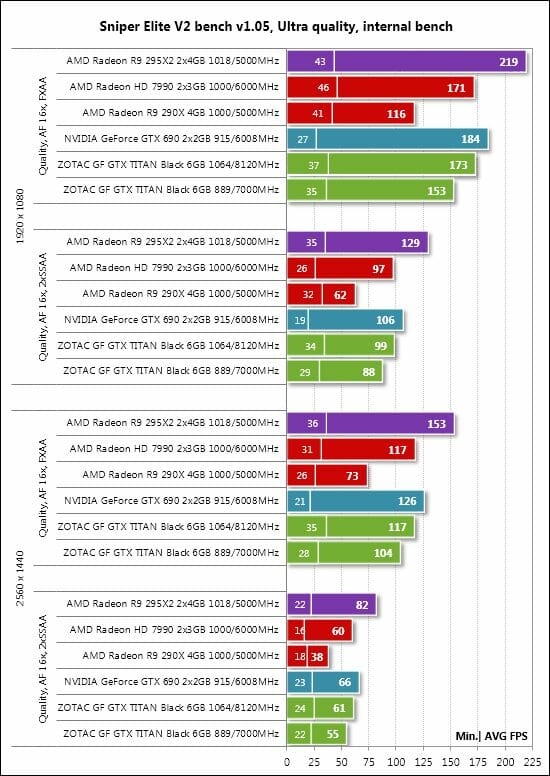
It is more than 100% ahead of the Radeon R9 290X in some test modes, which must be due to its higher GPU clock rate, efficient CrossFireX implementation and high-performance cooler. The cooler prevents GPU throttling which plagues the reference Radeon R9 290X. The gap from the dual-processor Radeon HD 7990 is smaller, yet amounts to 36.7%. The 2-year-old GeForce GTX 690 must be given credit for once again beating the overclocked Zotac GeForce GTX Titan Black.
Sleeping Dogs
The AMD Radeon R9 295X2 is twice as fast as the Radeon R9 290X in this game, too.
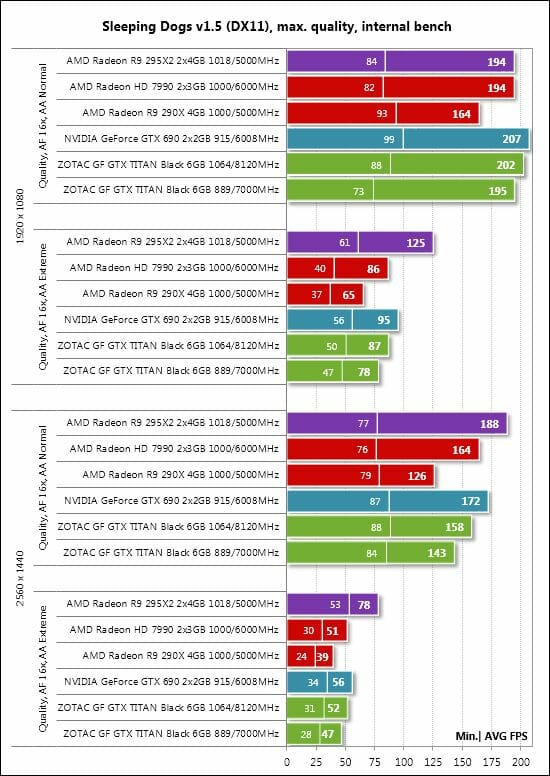
We mean the highest load, i.e. 2560×1440 pixels with antialiasing turned on. The new card is also 52.9% faster than the dual-processor Radeon HD 7990. The Nvidia GeForce GTX 690 is second, followed by the overclocked Zotac GeForce GTX Titan Black.
Hitman: Absolution
This game produces the same standings as the previous one:
The AMD Radeon R9 295X2 is up to 97% and 45% faster than the Radeon R9 290X and Radeon HD 7990, respectively. Judging by the rather low frame rates at the highest settings, the new dual-processor flagship is going to come in handy for owners of large monitors. The overclocked Zotac GeForce GTX Titan Black goes neck and neck with the Nvidia GeForce GTX 690 but can’t beat it.
Crysis 3
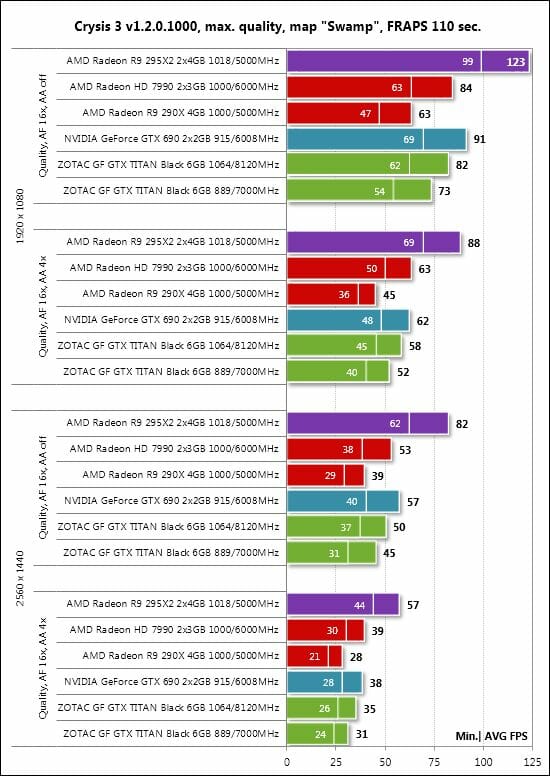
Still remaining one of the most resource-consuming 3D games, Crysis 3 puts the AMD Radeon R0 295X2 at least 95% higher than the Radeon R9 290X. The new card is also 54.7% faster than the Radeon HD 7990. The latter is also outperformed by the Nvidia GeForce GTX 690 in the AA-less modes but goes 1 fps ahead with antialiasing turned on. The overclocked Zotac GeForce GTX Titan Black is once again slower than the regular Nvidia GeForce GTX 690.
Tomb Raider (2013)
Like in Crysis 3, the new AMD Radeon R9 295X2 performs brilliantly. Its bottom speed is higher than the average frame rate of the other products!
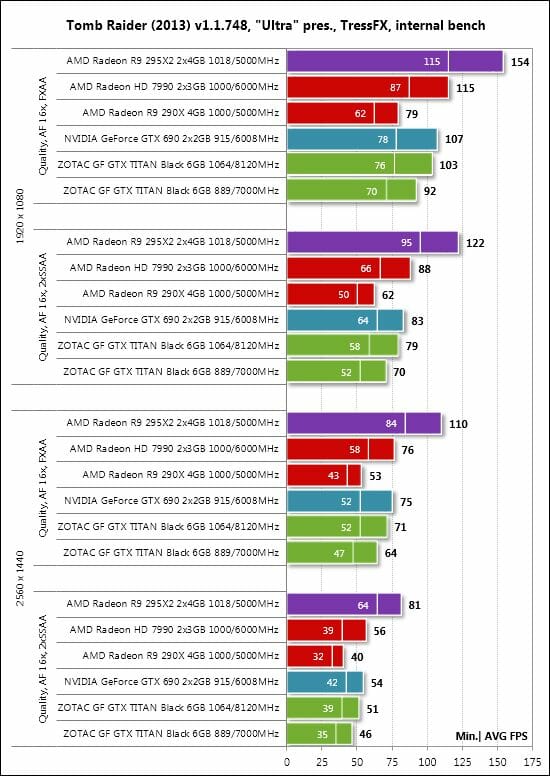
The AMD Radeon R9 290X is 95 to 108% slower than the new dual-processor flagship whereas the AMD Radeon HD 7990 is slower by 34 to 45%. The Nvidia GeForce GTX 690 is behind the AMD Radeon HD 7990 but ahead of the overclocked Zotac GeForce GTX Titan Black. The CrossFireX technology works smoothly in this game as is indicated by the high bottom speed.
BioShock Infinite
Every graphics card has problems with bottom speed in this game’s built-in benchmark, especially the Nvidia-based products.
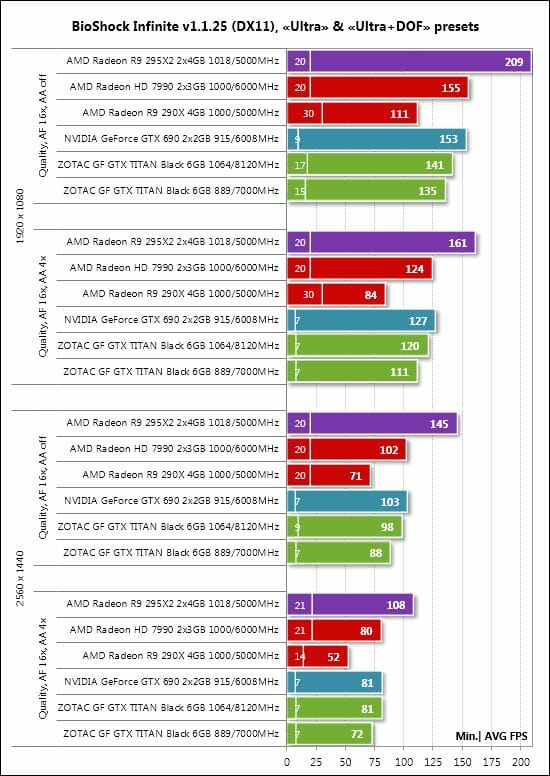
However, the game itself runs smoothly enough. Talking about average frame rates, the AMD Radeon R9 295X2 is twice as fast as the Radeon R9 290X and up to 42% ahead of the Radeon HD 7990. Second place is shared by three products in this test, meaning the Radeon HD 7990, GeForce GTX 690 and overclocked Zotac GeForce GTX Titan Black. It’s the seventh time in a row that the Zotac can’t beat the old GeForce GTX 690!
Metro: Last Light
When Advanced PhysX is turned on, the AMD Radeon R9 295X2 can’t win the test – for the first and only time in this test session.
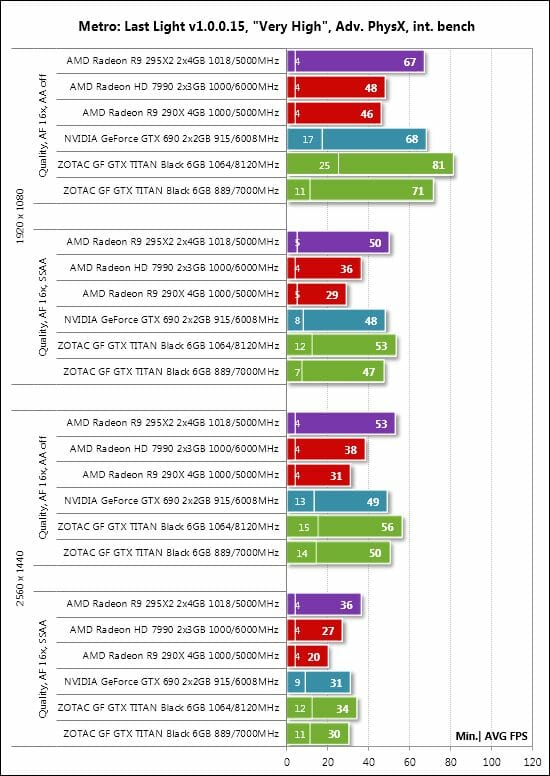
At these settings, the AMD-based products have very low bottom speeds. But the picture gets back to normal as soon as we disable the additional physics effects:
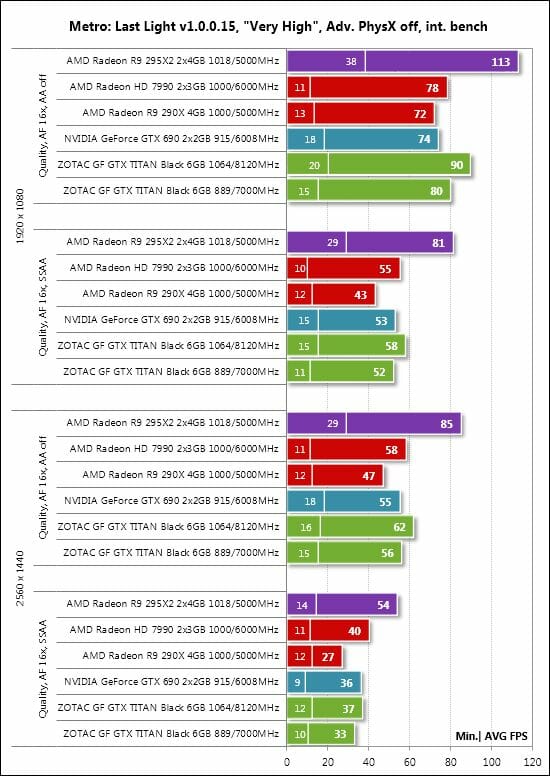
The AMD Radeon R9 295X2 is again twice as fast as the Radeon R9 290X and 47% ahead of the Radeon HD 7990. We can see the overclocked Zotac GeForce GTX Titan Black beat the GeForce GTX 690 for the first time in this test session but it’s clear that SLI technology is just not efficient in Metro: Last Light.
GRID 2
The AMD Radeon R9 295X2 sports astonishing performance in this racing simulator at the highest settings.
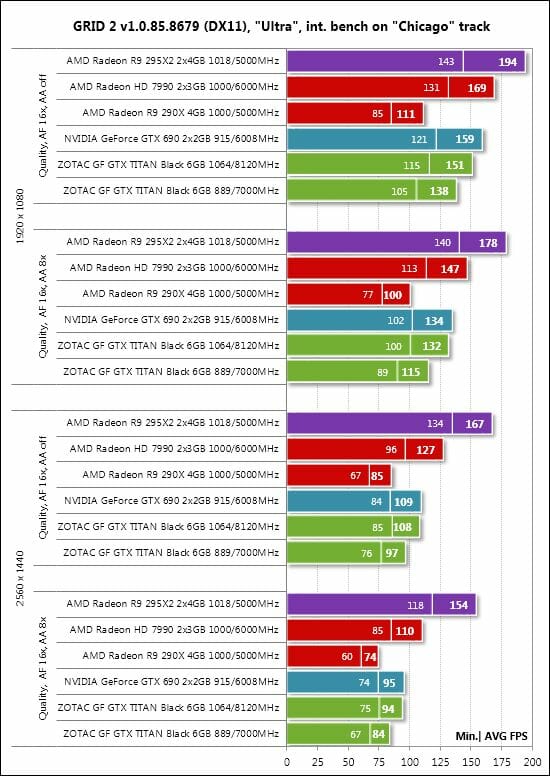
Its advantage over the Radeon R9 290X amounts to 108%. And it also beats the dual-processor Radeon HD 7990 by 40%.
Company of Heroes 2
It is in this game that the new AMD Radeon R9 295X2 enjoys its largest advantage over the Radeon HD 7990.
The advantage amounts to 65.7%. The Radeon R9 295X2 is also up to 87.1% faster than the Radeon R9 290X. That’s not a record for this test session, but a good result nonetheless. You have to use the AFR rendering mode to enable CrossFireX or SLI in Company of Heroes 2, which leads to flickering. That’s why the results of the dual-processor cards have little practical worth.
By the way, the GeForce GTX 690 falls behind the overclocked Zotac GeForce GTX Titan Black at 2560×1440 with antialiasing due to a lack of graphics memory among other factors.
Total War: Rome II
This game also requires that you enable AFR mode, but the flickering effect is only observed in its menu. We didn’t spot any visual artifacts during actual gameplay. The AMD Radeon R9 295X2 performs fast here.
It enjoys its largest advantage over the Radeon R9 290X in this test session – 122%! And it is also 57.8% ahead of the previous dual-processor flagship Radeon HD 7990. The overclocked Zotac GTX Titan Black is somewhat faster than the GeForce GTX 690.
Batman: Arkham Origins
The AMD Radeon R9 295X2 isn’t very fast in this game where it is rivalled by the two Nvidia-based products when antialiasing is turned off.
Well, top-end cards are bought for highest-quality visuals, and the Radeon R9 295X2 is superior at 2560×1440 with 8x MSAA. It is 82.9% and 29.9% ahead of the Radeon R9 290X and Radeon HD 7990, respectively.
Battlefield 4
The picture is generally the same as in Batman: Arkham Origins:
The AMD Radeon R9 295X2 is up to 109% ahead of the Radeon R9 290X and up to 37.1% faster than the Radeon HD 7990. The Nvidia GeForce GTX 690 is somewhat slower than the latter but beats the overclocked Zotac GeForce GTX Titan Black.
Thief
We want to remind you that we enable the Mantle API for the AMD-based products in Thief and Battlefield 4.
The AMD Radeon R9 295X2 isn’t as domineering in this game as in most of the other tests. It is only up to 75.6% and 32% ahead of the Radeon R9 290X and Radeon HD 7990, respectively. The overclocked Zotac GeForce GTX Titan Black is as much as 13.7% faster than the GeForce GTX 690 at the highest settings.
Here’s a table with the full test results.
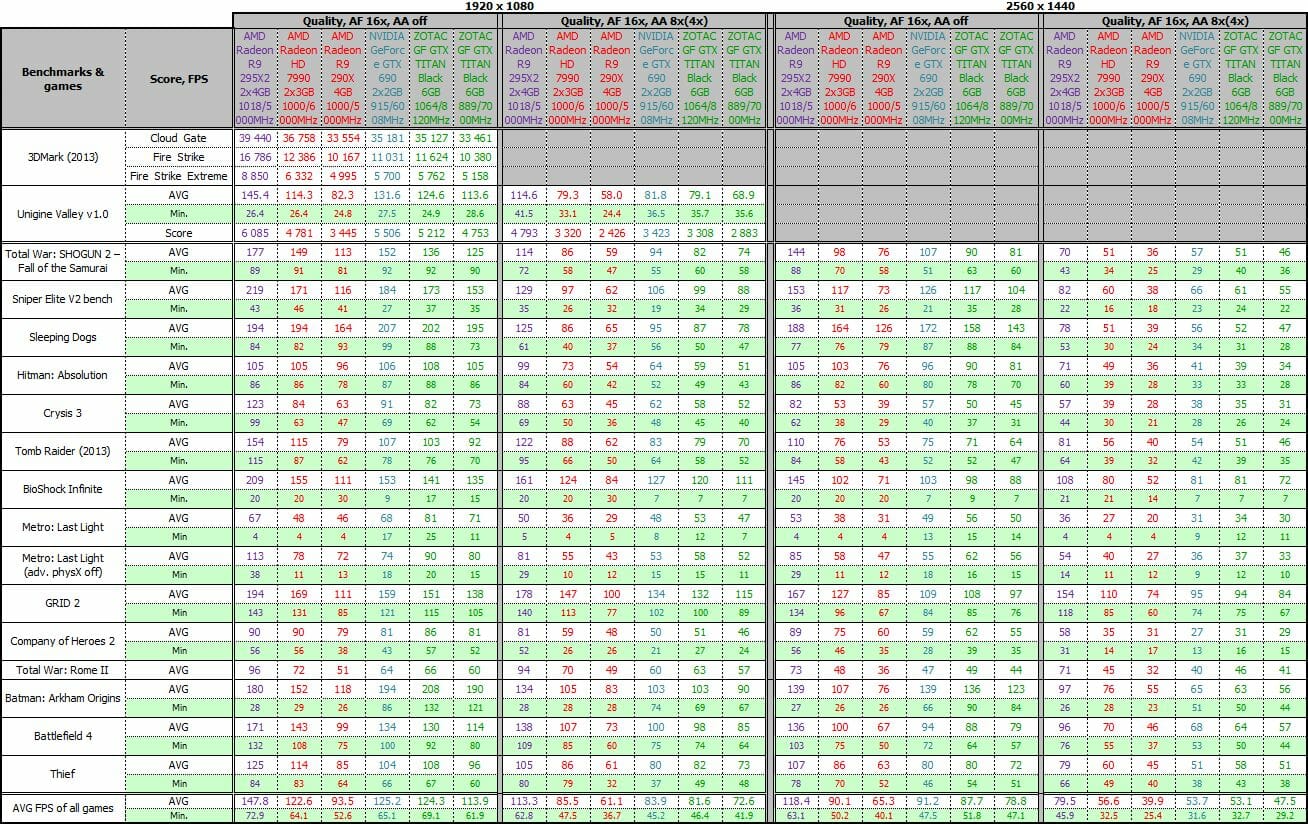
Performance Summary
First of all, let’s check out the difference between the AMD Radeon R9 295X2 and the Radeon R9 290X.
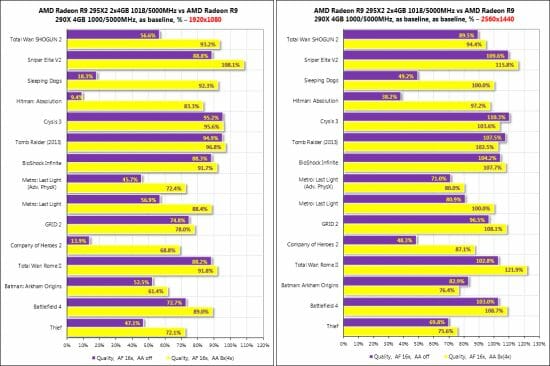
While its advantage isn’t so overwhelming at 1920×1080 pixels without antialiasing, the Radeon R9 295X2 is at least twice as fast as the single-processor card with comparable specs at 2560×1440 with various types of antialiasing. In fact, we compare a single Radeon R9 290X with a CrossFireX tandem built out of two such cards but such a CrossFireX configuration would have lower performance due to overheat and GPU throttling. Overall, the Radeon R9 295X2 is an average 98.6% ahead of the Radeon R9 290X across all the tests at the highest graphics quality settings.
The next pair of diagrams help compare the Radeon R9 295X2 and the dual-processor AMD Radeon HD 7990. Although the latter is almost out of the market now and cost $500 less, this comparison is going to be interesting.
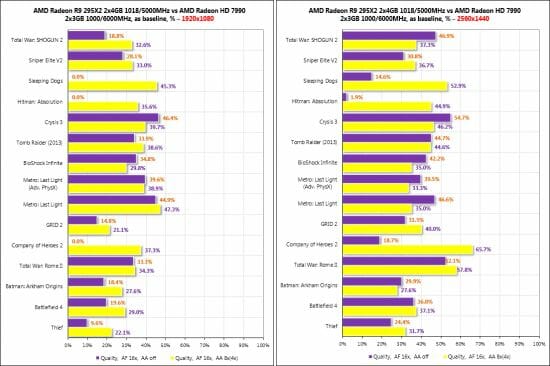
The Radeon HD 7990 is not as slow as the single-processor Radeon R9 290X, but the newer dual-processor card from AMD enjoys a 50% or higher advantage in quite a lot of games. Overall, the AMD Radeon R9 295X2 is an average 41.7% ahead of the Radeon HD 7990 at the highest visual quality settings.
And now let’s compare the AMD Radeon HD 7990 and the Nvidia GeForce GTX 690.
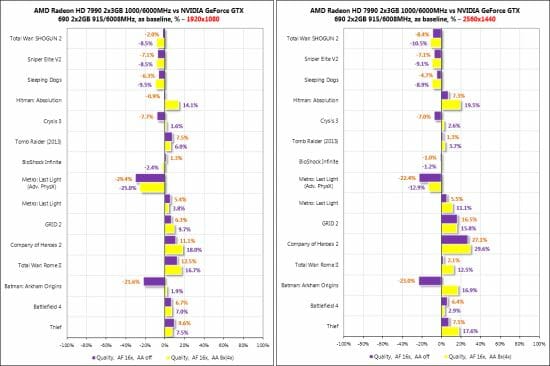
The GeForce GTX 690 is much faster in Metro: Last Light with Advanced PhysX turned on and in Batman: Arkham Origins without antialiasing. It also has some advantage in Total War: SHOGUN 2 – Fall of the Samurai, Sleeping Dogs, Sniper Elite V2 and Crysis 3 (without MSAA). The Radeon HD 7990, in its turn, wins in Metro: Last Light (without Advanced PhysX), Hitman: Absolution, Company of Heroes 2, Total War: Rome II, GRID 2, Battlefield 4, Thief and Batman: Arkham Origins (with antialiasing). The two cards are roughly equal to each other across all the tests.
And the last comparison is about whether the newest and overclocked Zotac GeForce GTX Titan Black can catch up with the dual-processor 2-year-old GeForce GTX 690.
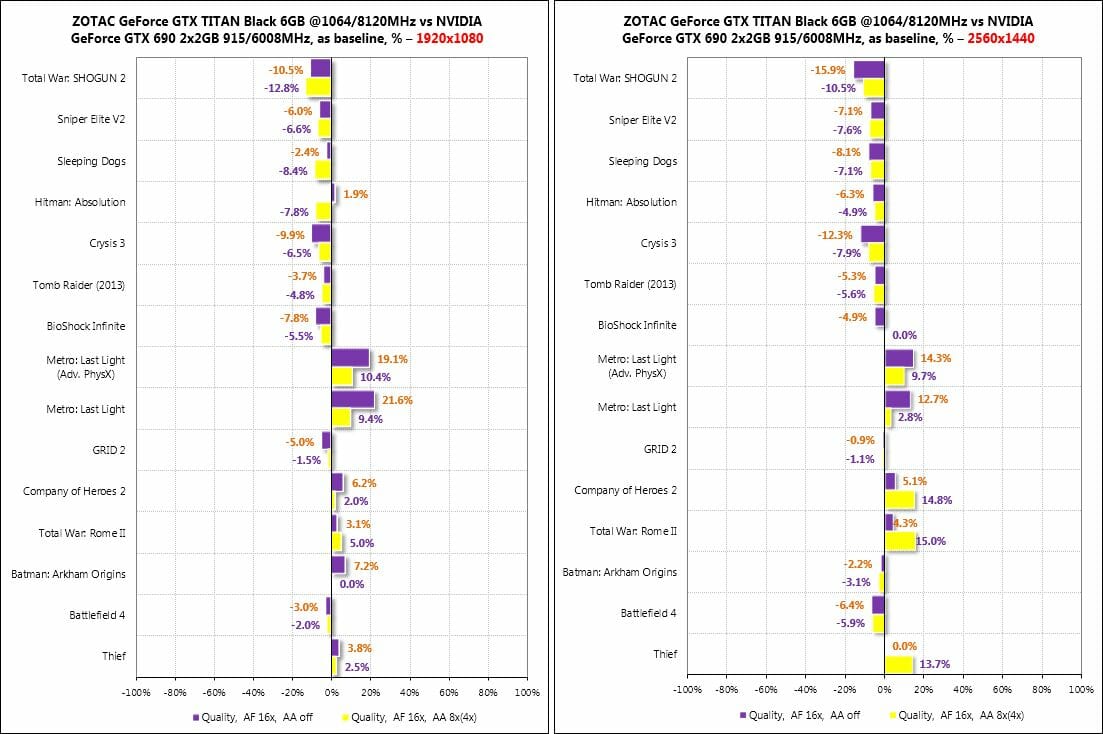
The Zotac GeForce GTX Titan Black does outperform the GeForce GTX 690 in those games where SLI technology doesn’t work smoothly, namely in Metro: Last Light, Company of Heroes 2, Total War: Rome II and Thief. In the rest of the games the regular GeForce GTX 690 is equal to or even faster than the overclocked Zotac. That dual-processor card has proved to be a truly future-proof product. We wonder if Nvidia might release its second revision with a base GPU clock rate of 1000 MHz or higher and efficient GPU Boost 2.0, with 4 GB of memory per GPU, and with a memory frequency of 7000 MHz. That would be a highly interesting and very fast graphics card (if priced at the same $999, of course).
Power Consumption
We measured the power consumption of computer systems with different graphics cards using a multifunctional panel Zalman ZM-MFC3 which can report how much power a computer (the monitor not included) draws from a wall socket. There were two test modes: 2D (editing documents in Microsoft Word and web surfing) and 3D (the intro scene of the Swamp level from Crysis 3 running four times in a loop at 2560×1440 with maximum visual quality settings but without MSAA). Here are the results:
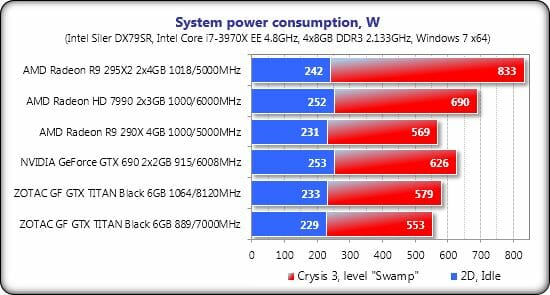
The AMD Radeon R9 295X2 configuration is voracious indeed. Its peak power draw of 833 watts is only 17 watts lower than the minimum PSU wattage recommended by AMD. This is 143 watts higher than required by the configuration with one Radeon HD 7990 and 207 higher compared to the GeForce GTX 690. The difference between the Radeon R9 295X2 and Radeon R9 290X is up to 264 watts. Considering the identical GPU configurations, memory amount (per each GPU) and clock rates, this number seems to be indicative of the peak power draw of one reference Radeon R9 290X.
We can also note the rather modest power requirements of the Zotac GeForce GTX Titan Black at its default clock rates. It needs no more than the Radeon R9 290X configuration. Considering the Titan’s higher performance, Nvidia’s top-end solutions seem to be more energy-efficient than AMD’s.
Conclusion
Now let’s do some math. First of all, the new AMD Radeon R9 295X2 has twice more GPUs than the Radeon R9 290X and clocks them at a 1.8% higher frequency. Second, the marketing department may claim the new card has twice the graphics memory, but that’s not true. There’s 4 GB per each GPU, just like on the Radeon R9 290X, so there’s no addition or multiplication. Third, the Radeon R9 295X2 has got a rather efficient and not very noisy liquid cooling system, which is an innovation for AMD. And quite a good one. To be specific, it gives you minus 30°C at peak loads. And finally, the new dual-processor flagship is more than three times as expensive as one Radeon R9 290X. Talking about retail prices, one Radeon R9 295X2 would cost you as much as three original Radeon R9 290X cards with high-performance air coolers. If combined into a single subsystem, such a trio would be faster than an R9 295X2. Thus, the new card is not really meant for the price-conscious.
Still, we like it. Our apprehensions about the Asetek liquid cooling system didn’t come true. The performance of the new card is unrivalled so far at the highest settings. The recently released Nvidia GeForce GTX Titan Z is twice as expensive and cannot be regarded as its market opponent.
So we witness the two GPU developers show their capabilities at designing super-fast graphics cards regardless of their price and market perspectives. Unfortunately, such demonstrations have little practical worth for the majority of users.